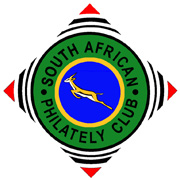Hotels of southern Africa
Quote from Steve on July 22, 2025, 12:24 pmAnother Grand Hotel, this one in Bloemfontein. Also the Hotel Imperial.
1908. Postcard. ‘Greetings from Bloemfontein. Grand Hotel and Theatre’ (Deale Bros., B’fontein).
The Grand Hotel stands to left. The Union flag flies above the Theatre.Entertainment was provided to the Imperial Garrison at the 900-seat Grand Theatre which stood alongside the older Grand Hotel in Hanger Street, near the railway station. At this time after the South African War (1899 - 1902) the European population of Bloemfontein was about 6.000, the majority Afrikaners. As the entertainment was almost exclusively provided by visiting British actors performing popular vaudeville comedy with song-and-dance routines the Theatre could only be filled if soldiers of the Imperial Garrison and their families attended. They came in their thousands to enjoy a sense of home and Britishness.
Hotel Imperial, Bloemfontein.
Circa 1904. Postcard. Unused. Hotel Imperial, Bloemfontein’. (No. 2604. Sallo Epstein & Co., Johannesburg.)
My guess is that the Hotel Imperial was more-or-less in the centre of town. This guess is based on the fact that it stood next door to the Post Office, the 'stripey' building on its extreme left. (Most town post offices were located in or close to their centres.) You can get a better view of the post office in the postcard below, also 'Garrison Newsagents' which sold postcards, possibly even this one.
Circa 1904. Real Photo Postcard. Unused. ‘Post Office and Imperial Hotel, Bloemfontein’. (E. H. Cox.)
The Garrison Newsagency, (J. Darling & Co.), extreme left, sought the custom of British troops from Tempe Camp.Troops of the Imperial Garrison based in Tempe Camp just outside Bloemfontein could buy postcards in the camp from SAGI (South African Garrison Institute) or in town from the Garrison Newsagency, left, conveniently situated behind Bloemfontein Post Office. Troops presumably enjoyed a drink or three in the Imperial Hotel, right, before returning to camp all ‘tickety-boo’.
Bloemfontein Post Office was PO Tempe’s Head Office.
Another Grand Hotel, this one in Bloemfontein. Also the Hotel Imperial.
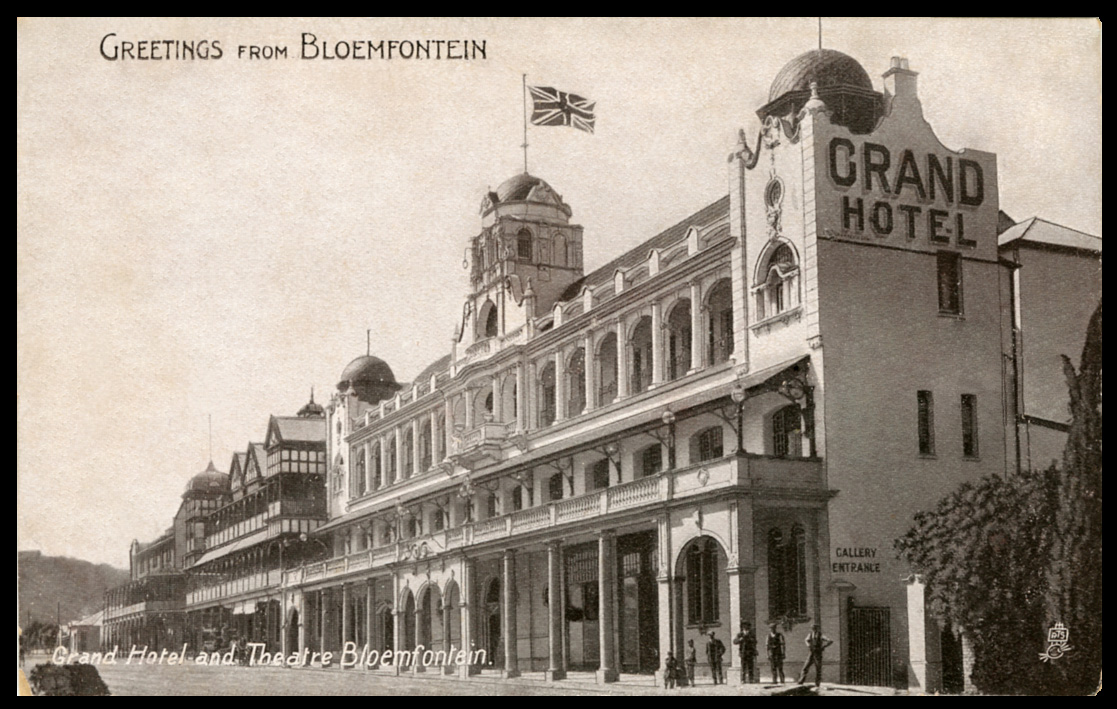
1908. Postcard. ‘Greetings from Bloemfontein. Grand Hotel and Theatre’ (Deale Bros., B’fontein).
The Grand Hotel stands to left. The Union flag flies above the Theatre.
Entertainment was provided to the Imperial Garrison at the 900-seat Grand Theatre which stood alongside the older Grand Hotel in Hanger Street, near the railway station. At this time after the South African War (1899 - 1902) the European population of Bloemfontein was about 6.000, the majority Afrikaners. As the entertainment was almost exclusively provided by visiting British actors performing popular vaudeville comedy with song-and-dance routines the Theatre could only be filled if soldiers of the Imperial Garrison and their families attended. They came in their thousands to enjoy a sense of home and Britishness.
Hotel Imperial, Bloemfontein.
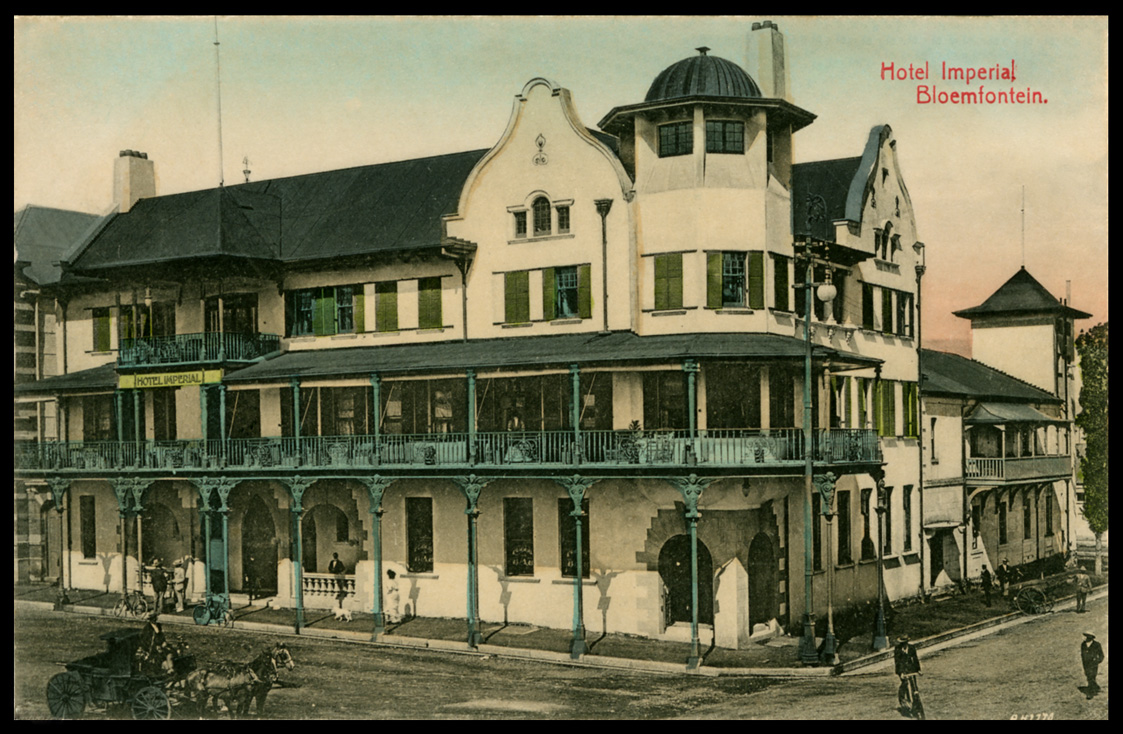
Circa 1904. Postcard. Unused. Hotel Imperial, Bloemfontein’. (No. 2604. Sallo Epstein & Co., Johannesburg.)
My guess is that the Hotel Imperial was more-or-less in the centre of town. This guess is based on the fact that it stood next door to the Post Office, the 'stripey' building on its extreme left. (Most town post offices were located in or close to their centres.) You can get a better view of the post office in the postcard below, also 'Garrison Newsagents' which sold postcards, possibly even this one.
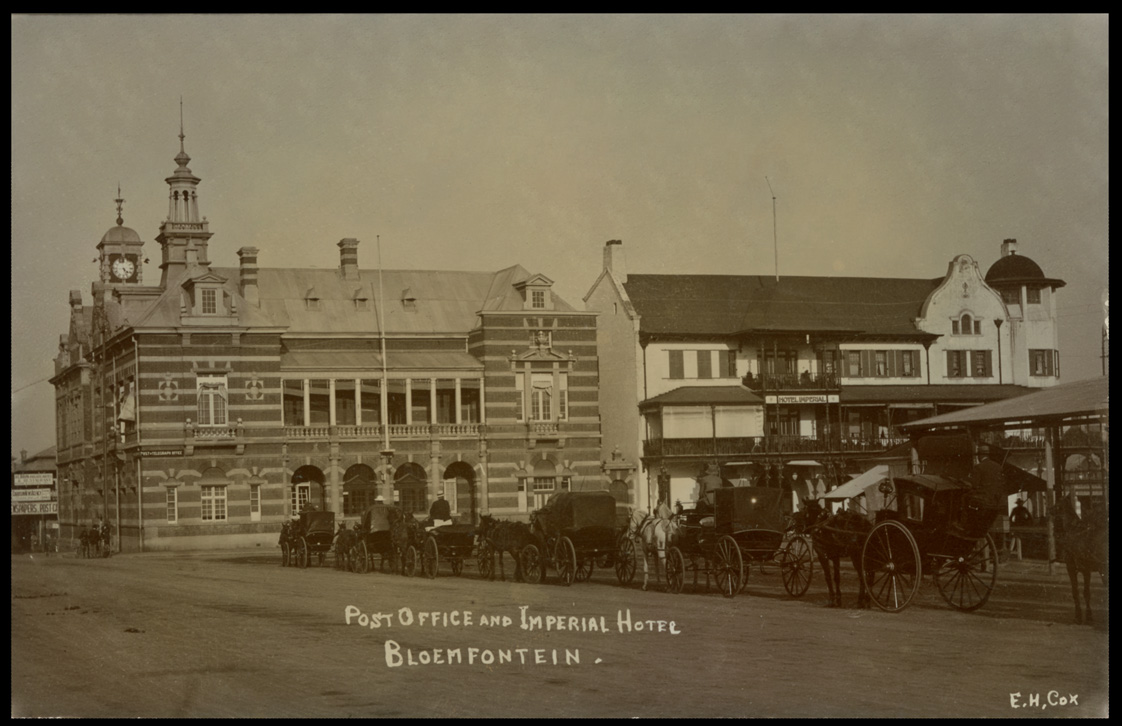
Circa 1904. Real Photo Postcard. Unused. ‘Post Office and Imperial Hotel, Bloemfontein’. (E. H. Cox.)
The Garrison Newsagency, (J. Darling & Co.), extreme left, sought the custom of British troops from Tempe Camp.
Troops of the Imperial Garrison based in Tempe Camp just outside Bloemfontein could buy postcards in the camp from SAGI (South African Garrison Institute) or in town from the Garrison Newsagency, left, conveniently situated behind Bloemfontein Post Office. Troops presumably enjoyed a drink or three in the Imperial Hotel, right, before returning to camp all ‘tickety-boo’.
Bloemfontein Post Office was PO Tempe’s Head Office.
Quote from Steve on August 31, 2025, 9:32 amThe Mount Nelson Hotel, Cape Town.
1901. Postcard. Mount Nelson Hotel, Cape Town. GPO CAPE TOWN '28 AUG 01' to Germany.
Posted just two-and-a-half years after it opened, this is an early view of the Mount Nelson in its original form.
The garden appears bare in places and has yet to establish itself compared to later views.No article or display on South African Hotels would be complete without a lengthy mention of the Mount Nelson. It deserves to be first on any list. For many years it was the first choice of premier hotel for the well-heeled, First-Class Castle line passengers visiting Cape Town. Today it blends colonial heritage with contemporary elegance as it continues to host prestigious global elites within its nine-acre gardens.
Circa 1907. COGH Postcard. Mount Nelson Hotel, Cape Town. (GB Budricks, No 220.) SALT RIVER 'FE 27 07' to GB.
This postcard was posted some 7 years after the Mount Nelson was built ie. this is probably its original appearance.
This is a view of the front of the hotel.The Mount Nelson Hotel nestles at the foot of Table Mountain in Cape Town. Its history is rooted in the Cape Colony, its relationship with the sea and imperial power. The land was originally granted in 1743 to Baron Pieter van Rheede van Oudtshoorn, who died before assuming his governorship of the Dutch colony. As early as 1806, the start of the second British occupation of the Cape, the property was dubbed "Mount Nelson" in honor of Admiral Lord Horatio Nelson. Sir Hamilton Ross acquired it in 1843, transforming it into a magnificent estate with gardens featuring deer, fountains, and ornamental elements that partially survive today.
Circa 1912. Union-Castle Line Booklet Postcard. 'Mount Nelson Hotel, Cape Town. (Copyright.)
This is a distorted view of the front of the hotel, possibly using a fish-eye lens.In 1890, shipping tycoon Sir Donald Currie bought the site to create a luxurious haven for his Castle Line's First-Class passengers,. Currie's aim was to rival leading London hotels. He succeeded. The hotel opened on March 6, 1899 as South Africa's first with hot and cold running water, earning acclaim for its opulence. The thistles in the Mount Nelson logo below refer to Currie's Scottish ancestry.
1900. Mount Nelson Stationery. (ex the Strakosch Mount Nelson correspondence.)
Inset. Henry Strakosch, left, Chairman of the Ango-Austrian Bank and the imperialist Winston Churchill, right.
These two possibly met in the Mount Nelson Hotel in 1900 where Strakosch was a wealthy Uitlander refugee.
In the 1930s, Strakosch gave the bankrupt Churchill a large amount of money, perhaps as much as £20,000.
Strakosch was alarmed by the rise of the Nazis while Churchill worried about German rearmament.
This 'gift' from one associate to another led to the charge that Churchill was in the pay of Zionists.In October 1899, the simmering hostility between the two Boer republics and the British Empire exploded into the full-scale South African War (1899 - 1902). In the early days of the war the Mount Nelson Hotel was briefly the British military headquarters. Generals Buller and Kitchener and Lords Roberts were frequent guests, as was the young war correspondent Winston Churchill who stayed there before his capture by the Boers and after his escape from them. Churchill lauded the Mount Nelson as "a most excellent and well-appointed establishment." Today the Writing Room continues to be named after him.
1900. Letter. PRETORIA (FPO 36) 'JU 27 00' to Cape Town.
Pretoria had fallen on 5th June 1900 - Lord Roberts was keen to go home.
A senior British officer, perhaps Lord Roberts' ADC, is writing to the Mount Nelson.Post-SAW, the hotel symbolized peace when it was painted in its signature pink in 1918 to mark World War I's end, a hue that became iconic, trademarked as "Mount Nelson Pink." The 1920s brought royal glamour with the Prince of Wales' 1925 visit, prompting the palm-lined driveway and the "Prince of Wales Gate" During Sir Arthur Conan Doyle's 1928 stay he held controversial séances. Doyle regarded himself not as a Christians but as a spiritualist. This rather disturbed the guests and the hotel's management.
Circa 1928. 'Mount Nelson Hotel, Cape Town. Main Entrance'.
This is probably the back entrance, not the 'Main Entrance'.The hotel was expanded with the Oasis wing in 1973. The Garden Cottage Suites were restored in 1990, Historic buildings like Helmsley (site of Cape Town's first Jewish service) was acqured in 1996. An electrical fire in 1993 led to a six-month closure for repairs. The hotel has attracted royalty, writers, musicians, and world leaders since its opening in 1899. Among its famous guests are Nelson Mandela, Winston Churchill, and Queen Elizabeth II, and cultural icons such as Agatha Christie, John Lennon, the Dalai Lama, David Bowie, and Oprah Winfrey.
Circa 1930. By this time the Mount Nelson has been decorated in what would become its trademark pink.
This sketch shows the front of the hotel much as it is in the first PC, top above, in 1907.Among modern celebrities, John Lennon stayed incognito as "Mr. Greenwood" in late May 1980, shortly before his death, meditating on Table Mountain, making his own bed, practicing yoga in the gardens (once mistaken for a vagrant), and exploring the city with a local taxi driver. Today, as Belmond Mount Nelson, it endures as an iconic five-star luxury hotel, earning Forbes accolades in 2023 and celebrating its 125th anniversary in 2024 with grand events like a massive cake-cutting ceremony. (Marie Antonette would have approved!)
1956. Union -Castle Line Year Book & Guide to Southern Africa.
If anyone can advise about the 'mystery' of these postcards peculiar views, please do so.
The Mount Nelson Hotel, Cape Town.
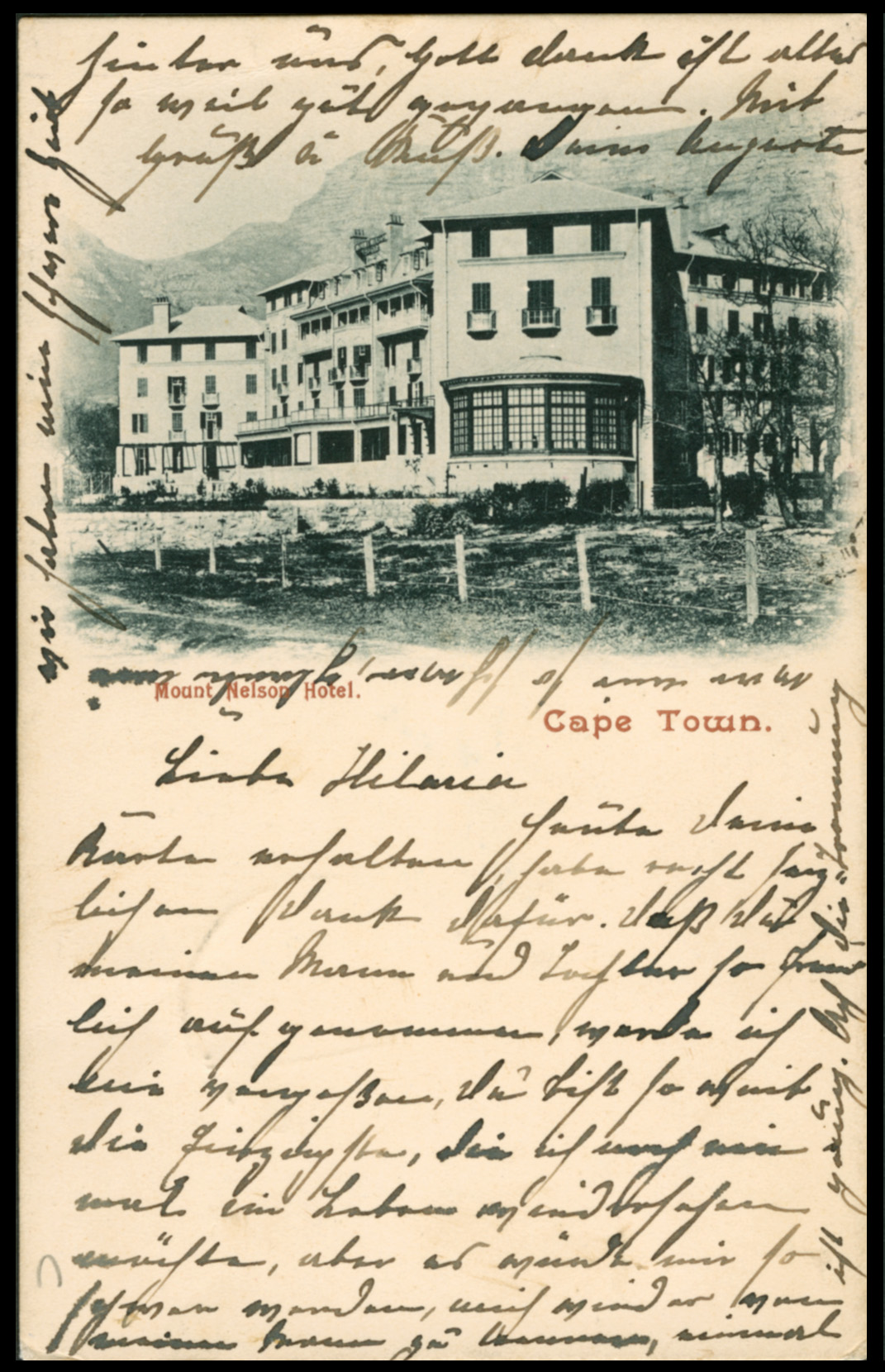
1901. Postcard. Mount Nelson Hotel, Cape Town. GPO CAPE TOWN '28 AUG 01' to Germany.
Posted just two-and-a-half years after it opened, this is an early view of the Mount Nelson in its original form.
The garden appears bare in places and has yet to establish itself compared to later views.
No article or display on South African Hotels would be complete without a lengthy mention of the Mount Nelson. It deserves to be first on any list. For many years it was the first choice of premier hotel for the well-heeled, First-Class Castle line passengers visiting Cape Town. Today it blends colonial heritage with contemporary elegance as it continues to host prestigious global elites within its nine-acre gardens.
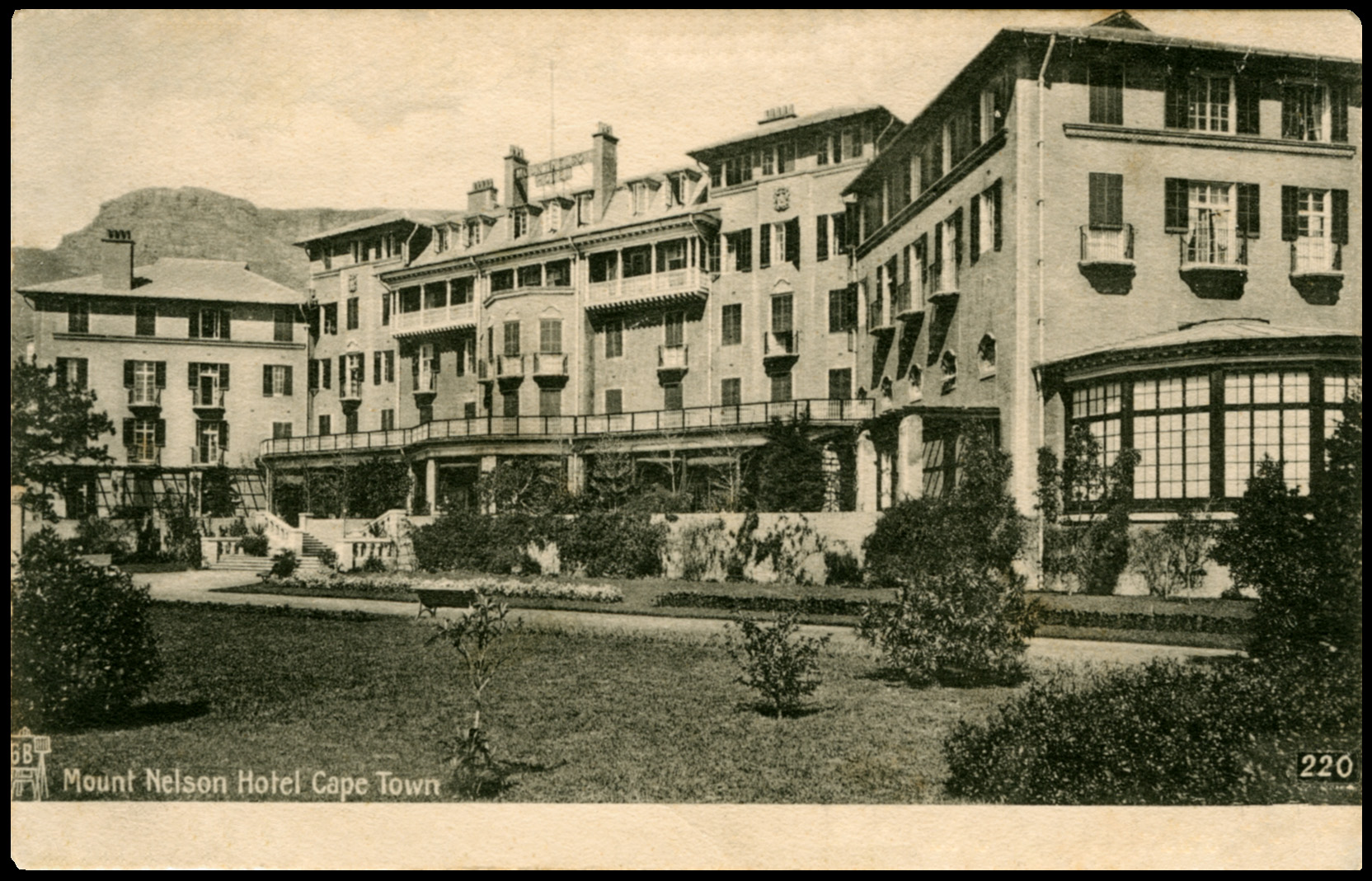
Circa 1907. COGH Postcard. Mount Nelson Hotel, Cape Town. (GB Budricks, No 220.) SALT RIVER 'FE 27 07' to GB.
This postcard was posted some 7 years after the Mount Nelson was built ie. this is probably its original appearance.
This is a view of the front of the hotel.
The Mount Nelson Hotel nestles at the foot of Table Mountain in Cape Town. Its history is rooted in the Cape Colony, its relationship with the sea and imperial power. The land was originally granted in 1743 to Baron Pieter van Rheede van Oudtshoorn, who died before assuming his governorship of the Dutch colony. As early as 1806, the start of the second British occupation of the Cape, the property was dubbed "Mount Nelson" in honor of Admiral Lord Horatio Nelson. Sir Hamilton Ross acquired it in 1843, transforming it into a magnificent estate with gardens featuring deer, fountains, and ornamental elements that partially survive today.
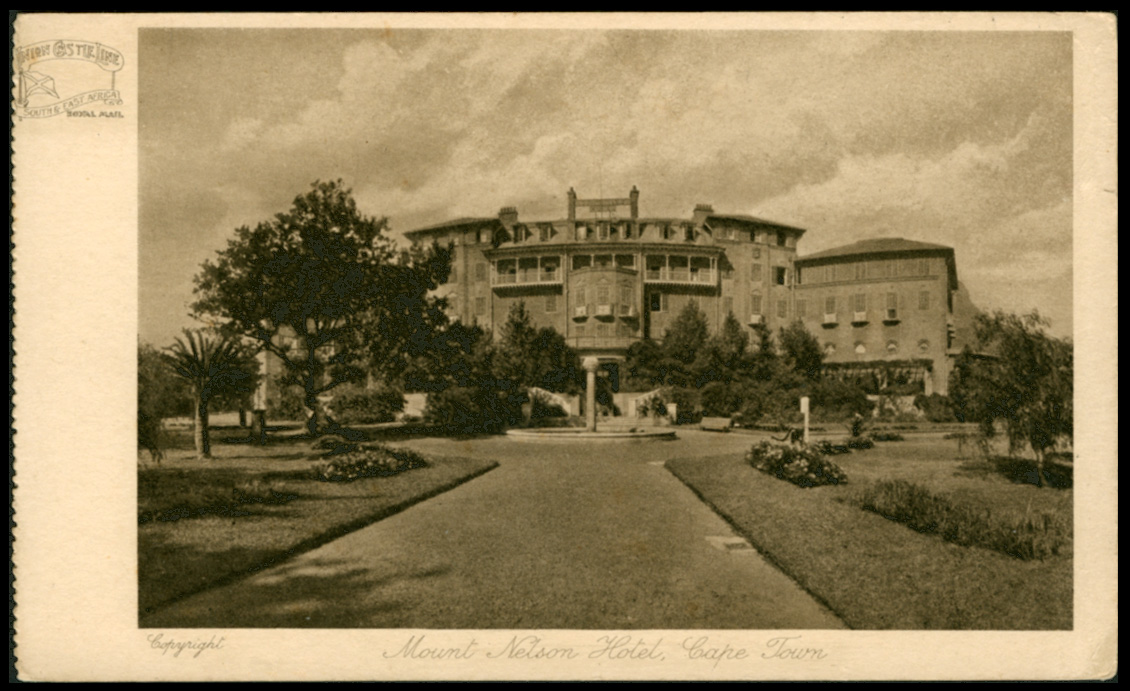
Circa 1912. Union-Castle Line Booklet Postcard. 'Mount Nelson Hotel, Cape Town. (Copyright.)
This is a distorted view of the front of the hotel, possibly using a fish-eye lens.
In 1890, shipping tycoon Sir Donald Currie bought the site to create a luxurious haven for his Castle Line's First-Class passengers,. Currie's aim was to rival leading London hotels. He succeeded. The hotel opened on March 6, 1899 as South Africa's first with hot and cold running water, earning acclaim for its opulence. The thistles in the Mount Nelson logo below refer to Currie's Scottish ancestry.
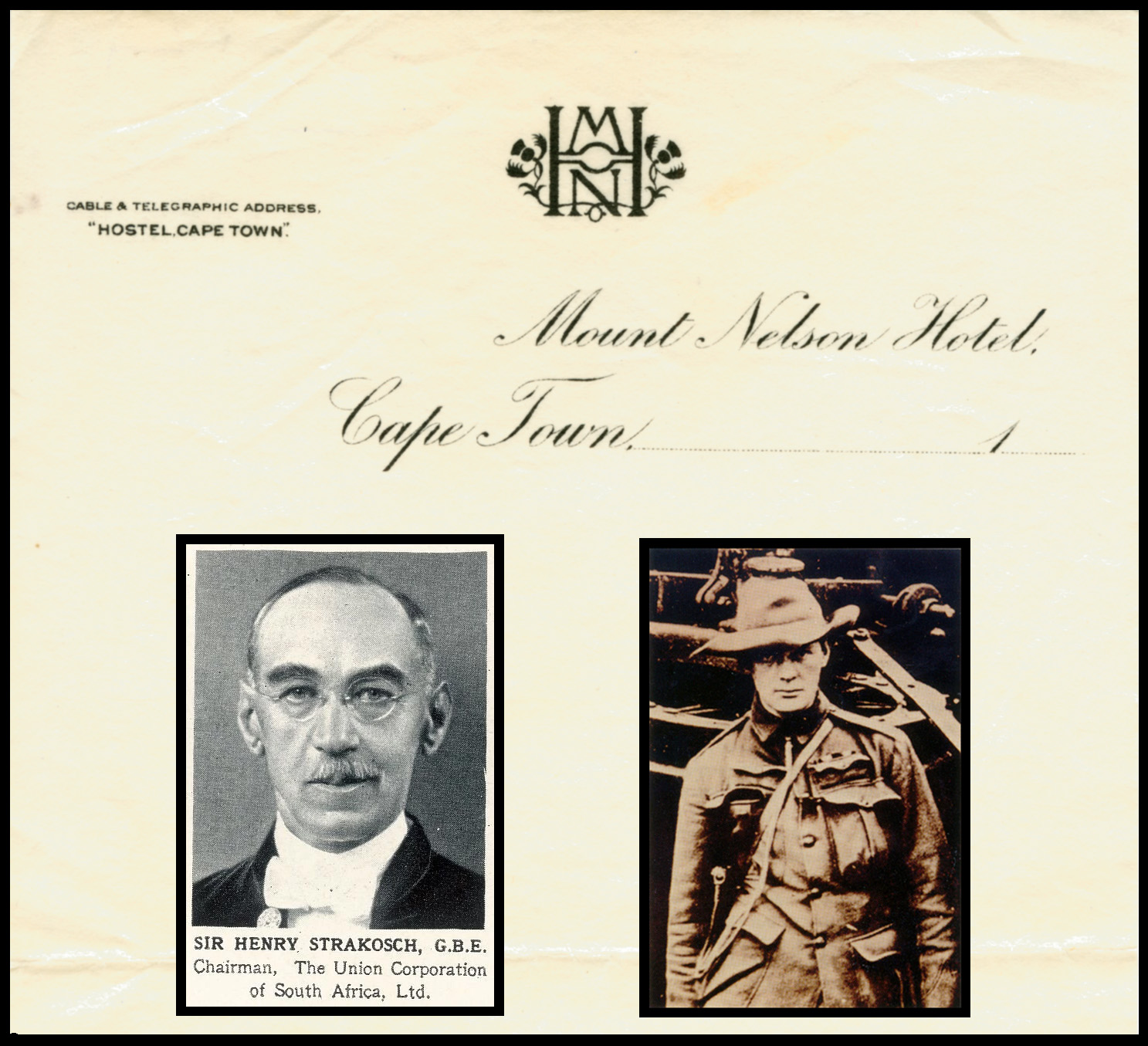
1900. Mount Nelson Stationery. (ex the Strakosch Mount Nelson correspondence.)
Inset. Henry Strakosch, left, Chairman of the Ango-Austrian Bank and the imperialist Winston Churchill, right.
These two possibly met in the Mount Nelson Hotel in 1900 where Strakosch was a wealthy Uitlander refugee.
In the 1930s, Strakosch gave the bankrupt Churchill a large amount of money, perhaps as much as £20,000.
Strakosch was alarmed by the rise of the Nazis while Churchill worried about German rearmament.
This 'gift' from one associate to another led to the charge that Churchill was in the pay of Zionists.
In October 1899, the simmering hostility between the two Boer republics and the British Empire exploded into the full-scale South African War (1899 - 1902). In the early days of the war the Mount Nelson Hotel was briefly the British military headquarters. Generals Buller and Kitchener and Lords Roberts were frequent guests, as was the young war correspondent Winston Churchill who stayed there before his capture by the Boers and after his escape from them. Churchill lauded the Mount Nelson as "a most excellent and well-appointed establishment." Today the Writing Room continues to be named after him.
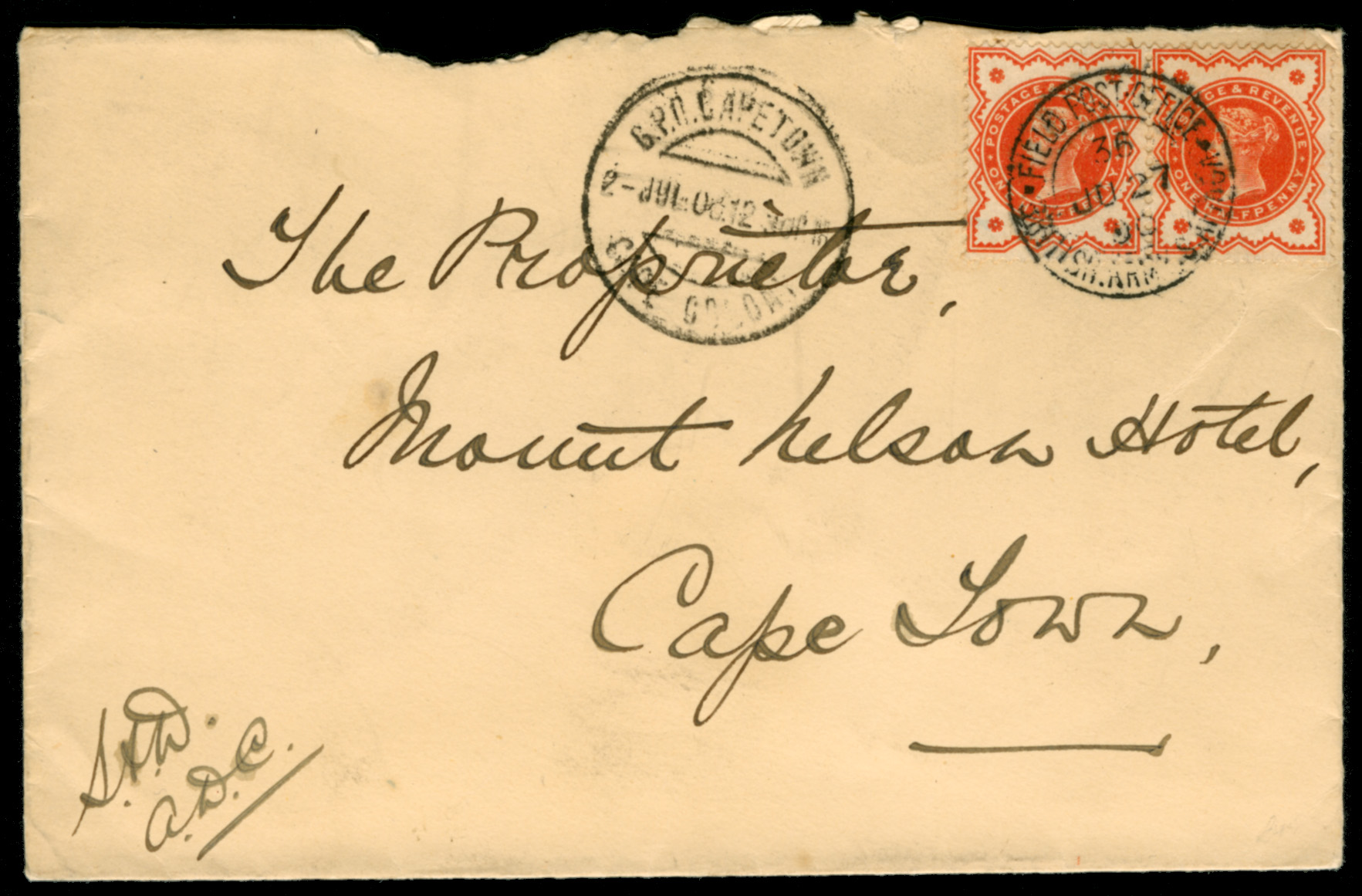
1900. Letter. PRETORIA (FPO 36) 'JU 27 00' to Cape Town.
Pretoria had fallen on 5th June 1900 - Lord Roberts was keen to go home.
A senior British officer, perhaps Lord Roberts' ADC, is writing to the Mount Nelson.
Post-SAW, the hotel symbolized peace when it was painted in its signature pink in 1918 to mark World War I's end, a hue that became iconic, trademarked as "Mount Nelson Pink." The 1920s brought royal glamour with the Prince of Wales' 1925 visit, prompting the palm-lined driveway and the "Prince of Wales Gate" During Sir Arthur Conan Doyle's 1928 stay he held controversial séances. Doyle regarded himself not as a Christians but as a spiritualist. This rather disturbed the guests and the hotel's management.
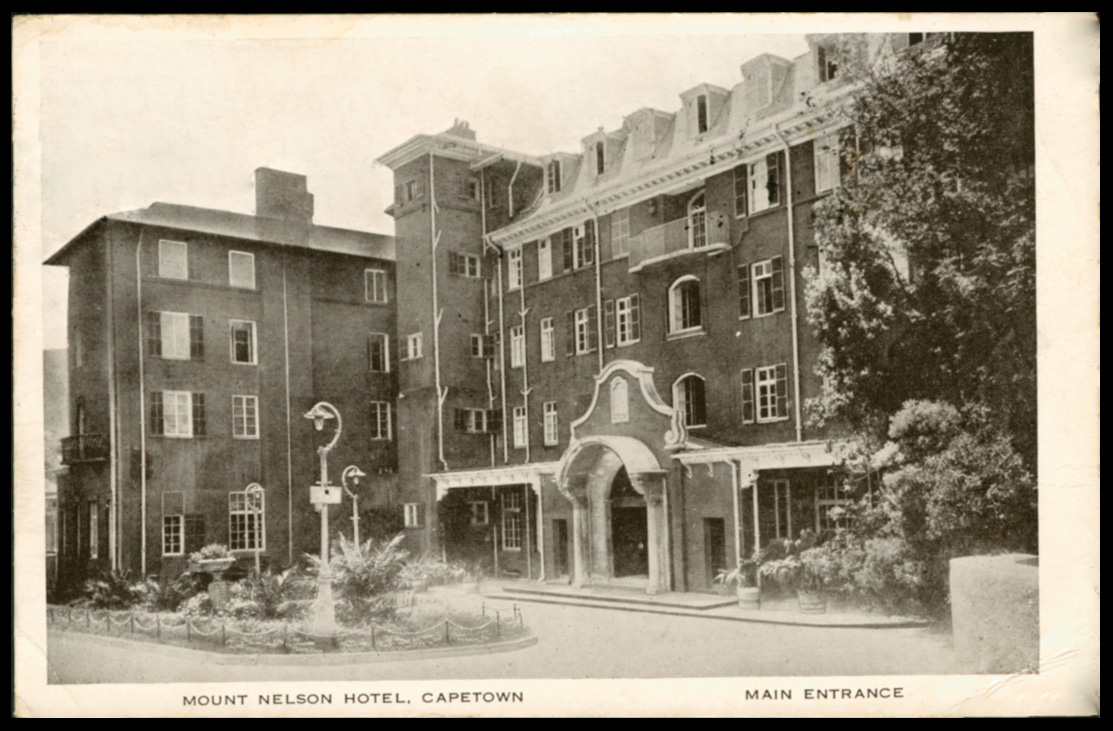
Circa 1928. 'Mount Nelson Hotel, Cape Town. Main Entrance'.
This is probably the back entrance, not the 'Main Entrance'.
The hotel was expanded with the Oasis wing in 1973. The Garden Cottage Suites were restored in 1990, Historic buildings like Helmsley (site of Cape Town's first Jewish service) was acqured in 1996. An electrical fire in 1993 led to a six-month closure for repairs. The hotel has attracted royalty, writers, musicians, and world leaders since its opening in 1899. Among its famous guests are Nelson Mandela, Winston Churchill, and Queen Elizabeth II, and cultural icons such as Agatha Christie, John Lennon, the Dalai Lama, David Bowie, and Oprah Winfrey.
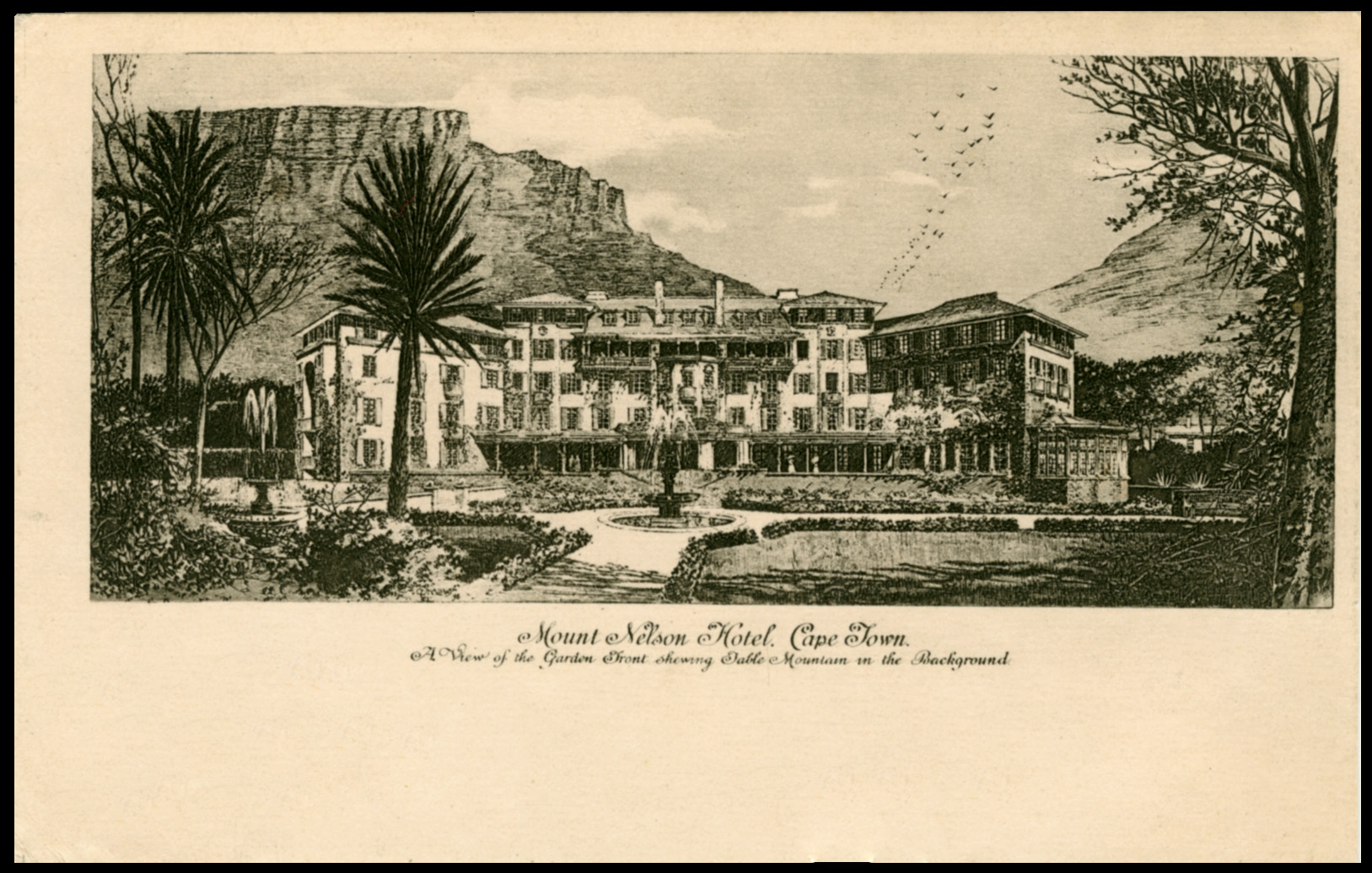
Circa 1930. By this time the Mount Nelson has been decorated in what would become its trademark pink.
This sketch shows the front of the hotel much as it is in the first PC, top above, in 1907.
Among modern celebrities, John Lennon stayed incognito as "Mr. Greenwood" in late May 1980, shortly before his death, meditating on Table Mountain, making his own bed, practicing yoga in the gardens (once mistaken for a vagrant), and exploring the city with a local taxi driver. Today, as Belmond Mount Nelson, it endures as an iconic five-star luxury hotel, earning Forbes accolades in 2023 and celebrating its 125th anniversary in 2024 with grand events like a massive cake-cutting ceremony. (Marie Antonette would have approved!)
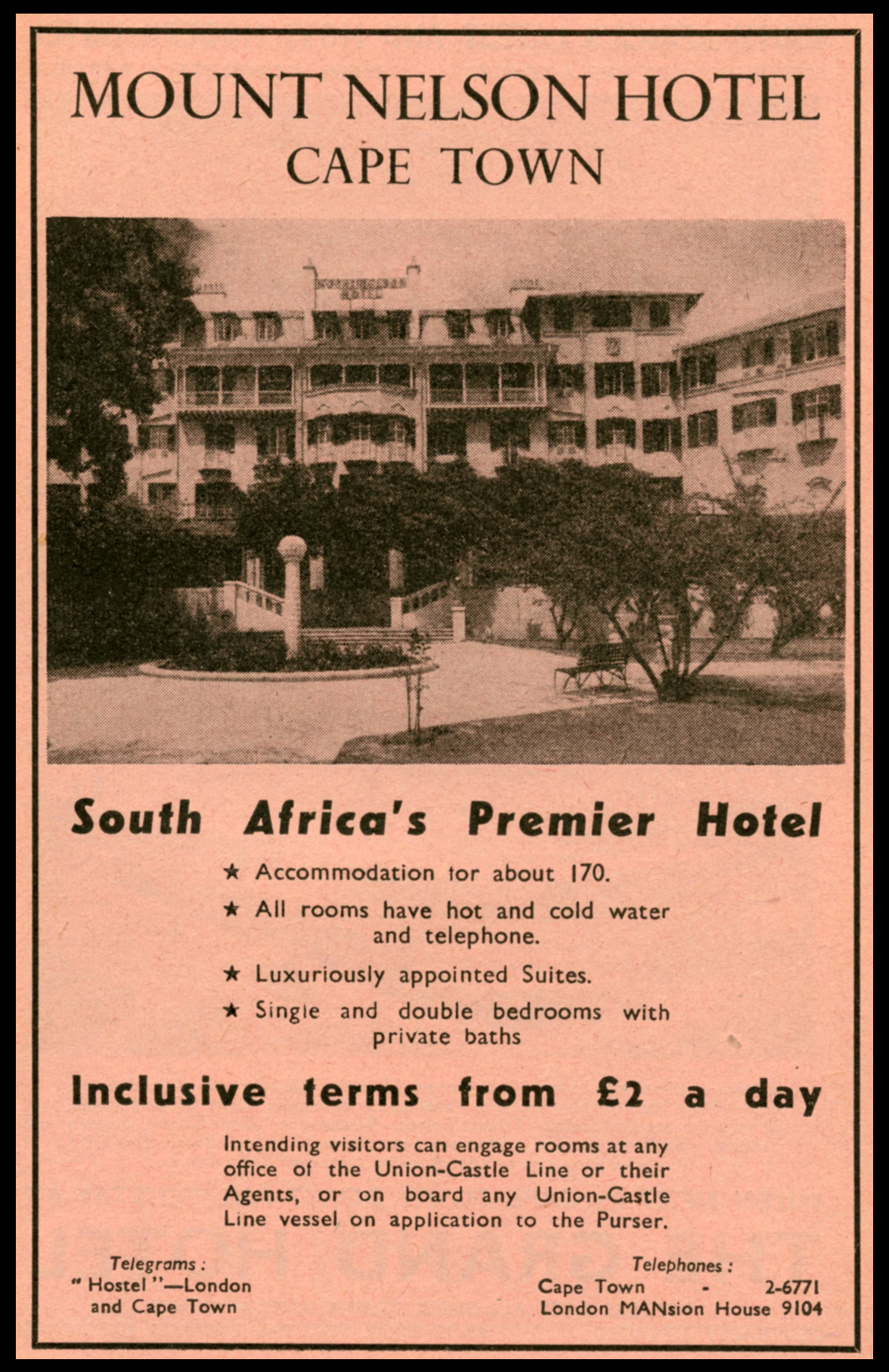
1956. Union -Castle Line Year Book & Guide to Southern Africa.
If anyone can advise about the 'mystery' of these postcards peculiar views, please do so.
Quote from Steve on September 5, 2025, 3:23 pmThe Wilderness Hotel - The Pearl of the Garden Route.
Circa 1955. Baggage Label. The Wilderness Hotel - The Pearl of the Garden Route.
Nestled in the heart of the Cape’s Garden Route, The Wilderness Hotel in Wilderness, Western Cape, is a historic gem that blends old-world charm with modern amenities. Within easy walking distance of golden sand beaches and surrounded by lush indigenous forests and lagoons, this 150-room hotel sits in a prime location, just a 45-minute drive from Mossel Bay and or Knysna. The nearby Garden Route National Park offer endless outdoor adventures from hiking to birdwatching. I attended a weekend conference here in the 1980s. I made an excuse to leave the meeting and popped outside for some fresh air. It was the only time I ever saw the famous Knysna Loerie.
The Wilderness Hotel - The Pearl of the Garden Route.

Circa 1955. Baggage Label. The Wilderness Hotel - The Pearl of the Garden Route.
Nestled in the heart of the Cape’s Garden Route, The Wilderness Hotel in Wilderness, Western Cape, is a historic gem that blends old-world charm with modern amenities. Within easy walking distance of golden sand beaches and surrounded by lush indigenous forests and lagoons, this 150-room hotel sits in a prime location, just a 45-minute drive from Mossel Bay and or Knysna. The nearby Garden Route National Park offer endless outdoor adventures from hiking to birdwatching. I attended a weekend conference here in the 1980s. I made an excuse to leave the meeting and popped outside for some fresh air. It was the only time I ever saw the famous Knysna Loerie.
Quote from Steve on September 24, 2025, 12:24 pmFree State Hotel, ORC
Our thanks to Richard Stroud RDPSA, President of the Orange Free State Study Circle, for the mysterious gem below. Very little is known about 'The Free State Hotel', Brandfort and its proprietor H.P. Basson. Your advice is welcomed. Please!
Circa 1903. Postcard. "Free State Hotel," Brandfort, ORC. (Prop. H. P. Basson.)
The OFS republic was formally annexed to the British Crown and renamed the ORC (Orange River Colony) on the 28th May 1900. However, a guerrilla war persisted for a further eighteen months and it was not until the 31st May 1902 that the war was formally ended by the signing of the Peace Treaty of Vereeniging (in Pretoria). This postcard places the hotel in the ORC era (1900 - 1910). I would suspect that its date is a little later than the end of the war. There is a soldier in full kit in the photo behind the sitting children.
As can be seen the hotel was busy with many guests. It had its own coach which was presumably used to convey its guests to and from Brandfort Railway Station. Most 'better' hotels provided such a service. While the '1956 Union Castle Line Year Book and Guide to Southern Africa' mentions Commercial and Grand National hotels in Brandfort it does not list a 'Free State Hotel' there.
Brandfort was established in 1866 on the farm Keerom. It sits pretty much in the centre of the Orange Free State, some 60 km northeast of Bloemfontein to which it is connected by railway. It was once the heart of a small but thriving rural farming community. During the Apartheid years Nelson Mandela's wife Winnie was banished to Brandfort where she was appallingly treated by the Security Police. Her apologists argue that it was this racial cruelty that caused her to change into an embittered and violent activist.
In 2020 the ANC government officially renamed the town 'Winnie Mandela' despite some of her actions during the liberation struggle being reprehensible. South African graffiti of the time read "Winnies in the Pooh'. She never quite cleaned up her act post-Apartheid. Today, Brandfort / Winne Mandela is a shadow of its former self, a ghost town with a dwindling economy where only 3% of its people are in full-time employment, the majority living on government grants. Well done Apartheid, its Security Police, Winnie Mandela and the ANC!
In the book, 'Winnie Mandela: A Life', she described Brandfort as: "A drab and dusty rural hamlet with unimaginative houses, an old-fashioned two-storey hotel, small shops lining the main street and a pervading atmosphere of lethargy and inactivity." This reference to "an old-fashioned two-storey hotel" almost certainly does not refer to the 'Free State Hotel' which seems to have disappeared years earlier. This is all the information I have been able to find out about this a hotel through cursory research. Your help please.
Stop Press
Further to reseaching the next postcard, I found a reference to a Harry Jacobson being the proprietor of the Frankfort Hotel in "circa 1915". As it is unlikely that this postcard shows a time after 1915, I must assume that it is from the time-frame 1903 - 1915.
Free State Hotel, ORC
Our thanks to Richard Stroud RDPSA, President of the Orange Free State Study Circle, for the mysterious gem below. Very little is known about 'The Free State Hotel', Brandfort and its proprietor H.P. Basson. Your advice is welcomed. Please!
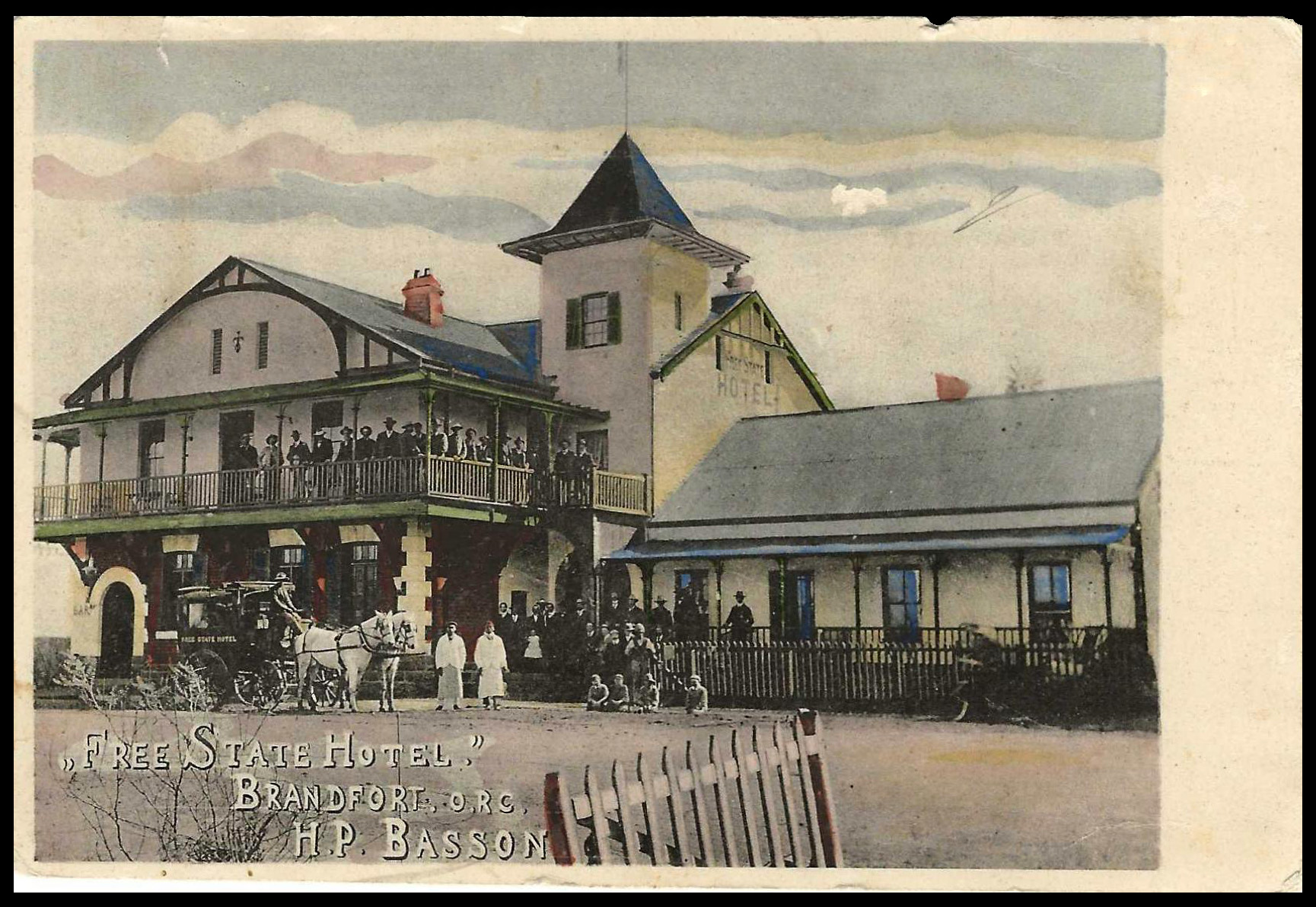
Circa 1903. Postcard. "Free State Hotel," Brandfort, ORC. (Prop. H. P. Basson.)
The OFS republic was formally annexed to the British Crown and renamed the ORC (Orange River Colony) on the 28th May 1900. However, a guerrilla war persisted for a further eighteen months and it was not until the 31st May 1902 that the war was formally ended by the signing of the Peace Treaty of Vereeniging (in Pretoria). This postcard places the hotel in the ORC era (1900 - 1910). I would suspect that its date is a little later than the end of the war. There is a soldier in full kit in the photo behind the sitting children.
As can be seen the hotel was busy with many guests. It had its own coach which was presumably used to convey its guests to and from Brandfort Railway Station. Most 'better' hotels provided such a service. While the '1956 Union Castle Line Year Book and Guide to Southern Africa' mentions Commercial and Grand National hotels in Brandfort it does not list a 'Free State Hotel' there.
Brandfort was established in 1866 on the farm Keerom. It sits pretty much in the centre of the Orange Free State, some 60 km northeast of Bloemfontein to which it is connected by railway. It was once the heart of a small but thriving rural farming community. During the Apartheid years Nelson Mandela's wife Winnie was banished to Brandfort where she was appallingly treated by the Security Police. Her apologists argue that it was this racial cruelty that caused her to change into an embittered and violent activist.
In 2020 the ANC government officially renamed the town 'Winnie Mandela' despite some of her actions during the liberation struggle being reprehensible. South African graffiti of the time read "Winnies in the Pooh'. She never quite cleaned up her act post-Apartheid. Today, Brandfort / Winne Mandela is a shadow of its former self, a ghost town with a dwindling economy where only 3% of its people are in full-time employment, the majority living on government grants. Well done Apartheid, its Security Police, Winnie Mandela and the ANC!
In the book, 'Winnie Mandela: A Life', she described Brandfort as: "A drab and dusty rural hamlet with unimaginative houses, an old-fashioned two-storey hotel, small shops lining the main street and a pervading atmosphere of lethargy and inactivity." This reference to "an old-fashioned two-storey hotel" almost certainly does not refer to the 'Free State Hotel' which seems to have disappeared years earlier. This is all the information I have been able to find out about this a hotel through cursory research. Your help please.
Stop Press
Further to reseaching the next postcard, I found a reference to a Harry Jacobson being the proprietor of the Frankfort Hotel in "circa 1915". As it is unlikely that this postcard shows a time after 1915, I must assume that it is from the time-frame 1903 - 1915.
Quote from Steve on September 25, 2025, 11:52 amFicksburg Hotel, Ficksburg, OFS.
Below is another postcard emailed to us from Richard Stroud RDPSA. Richard has established an excellent reputation as an unmatched researcher of the postal history of the Anglo-Boer War, aka the 'South African War', 1899 - 1902.
Richard writes "Regarding the Ficksburg Hotel PPC that I sent to you, (below), I stayed there for one night in July in the early 1980s. Never been so cold in my life! In the bar, there were some dyed-in-the-wool Afrikaners whittling wooden items, and behind the bar were two boards listing the names of the men of the Ficksburg Commando. However, the food was good. The following day, I found that a modern hotel was nearby!" Yes, people think it all 'Sunny South Africa' but they don't know about the interior's inversion of temperature in winter when a bucket of water left out overnight will turn into to ice. The winter cold is something that is mentioned a lot by British and other soldiers in their letters home. Pity the poor Boers then, sleeping in the veld, their homes burned down and their plump warm wives in concentration camps!
At first, there was not much readily available information on-line on the Ficksburg Hotel.... but then!.
Circa 1898 - 1920. Postcard. Ficksburg Hotel, Ficksburg, O.F.S. J. Jankielsohn, Proprietor'.
With a little research I was able to narrow the date of this photo down to about 10 years.This interesting postcard was difficult to date. I did not have a copy of its reverse. The postcard describes Ficksburg as being in the OFS (Orange Free State), an independent republic until the War saw it become a British colony, the ORC (Orange River Colony) in 1900 until 1910, (Union), when it became a province of the Union of South Africa called the Orange Free State. So, there is no specific clue to the date of the photo in its address. The brick and corrugated iron construction is typical of 1890 - 1920.
There are some clues in this postcard to its date which are not conclusive by themselves. The first is the sign for Castle Beers. Today, this thirst-quencher is usually referred to as 'Castle Lager'. (A lager is a type of beer.) Its history began in 1886 when Charles Glass established the Castle Brewery in Johannesburg. His 'Castle Beer' (not Lager) quickly became popular with the mining community. By 1889, 'The Digger’s News' described Glass' enterprise as a "success". In 1895, South African Breweries (SAB) was formed and two years later it was listed on the Johannesburg Stock Exchange (1897) ie. Castle Beer was popular before the SAW / ABW began in 1899. You can expect such a listed company to have an active marketing and promotions department producing advertising signage, etc..
In these early years SA Breweries' flagship product was 'Castle Beer'. This suggests that this photo could have been taken before the South African War of 1899 - 1902. Supporting this are the bicycles and two mule and or horse-drawn coaches that you can see and the absence of motor cars. Does this show that the photo was taken befor the arrival of motor cars?. Not really, all we can determine is that at this time in Ficksburg horse and carts remained the hotel's main means of transport. Given the devastation of the war it is possible that at this time few could afford motor vehicles. However, thirdly, the people gathered on the hotel's stoep (verandah) seem to be an affluent lot. Is this a happier time before the war? Perhaps. However, the hotel's name which is painted on its roof, a common practice, one which pilots in the early days of aviation in South Africa used as locational markers.
So, my first cautious guess was that the photo in this postcard could equally be from anytime between 1898 to 1920.
I now decided to research the proprietor of the Ficksburg Hotel, J. Jankielsohn. I should have started there. I found two references to him, the first a court case JANKIELSOHN v. REX of 7th July 1904 when he was the properietor of the Grand Hotel, Bloemfontein. This was a criminal procedure in which the charge was 'Permitting drunkenness.-Ordinance 8 of 1903, sec. 51, sub-sec. I.'
J (Jankielsohn) was the holder of a liquor license. He was charged with permitting drunkenness to take place in his retail liquor licensed premises. There was some evidence that J or his barmen had knowledge of a drunken man in the bar, if not they were culpably ignorant of his presence there. J was charged with permitting drunkenness to take place upon his retail liquor licensed premises known as the Grand Hotel, Bloemfontein. J was found guilty. The facts disclosed by the evidence show that on the night of the 10th June, 1904, 'a man went into the bar of the Grand Hotel in an intoxicated condition. He was staggering and being watched by two policemen who went into the bar a few minutes afterwards and found him sitting over a table with a bottle of Castle Beer to his lips'. Ha!
Okay, so now we know that J was the proprietor of the Grand Hotel, Bloemfontein, in 1904. In addition to this, I found this reference to J on-line, posted in 2005. entitled 'Hotel Proprietors in SA circa 1915'. This was cited in a ROOTSWEB List and names some hotel owners, apparently taken from the magazine ON THE ROAD (about 1915), one intended for South African commercial travellers, not proto-beatniks. Under 'F', it lists "Ficksburg Hotel, Ficksburg: J. JANKIELSOHN ("late proprietor Grand Hotel, Bloemfontein").
So there we have it, this postcard dates from some time after 1904 and "circa 1915". Let's say, 1920.
Please submit your thoughts., Thanks.
Footnote:
Dr Roy Jankielsohn (born 3 December 1967) is a South African politician who has been the leader of the opposition in the Free State Provincial Legislature since 2014. He has been the provincial leader of the Democratic Alliance (DA) in the Free State since 2020.
Ficksburg Hotel, Ficksburg, OFS.
Below is another postcard emailed to us from Richard Stroud RDPSA. Richard has established an excellent reputation as an unmatched researcher of the postal history of the Anglo-Boer War, aka the 'South African War', 1899 - 1902.
Richard writes "Regarding the Ficksburg Hotel PPC that I sent to you, (below), I stayed there for one night in July in the early 1980s. Never been so cold in my life! In the bar, there were some dyed-in-the-wool Afrikaners whittling wooden items, and behind the bar were two boards listing the names of the men of the Ficksburg Commando. However, the food was good. The following day, I found that a modern hotel was nearby!" Yes, people think it all 'Sunny South Africa' but they don't know about the interior's inversion of temperature in winter when a bucket of water left out overnight will turn into to ice. The winter cold is something that is mentioned a lot by British and other soldiers in their letters home. Pity the poor Boers then, sleeping in the veld, their homes burned down and their plump warm wives in concentration camps!
At first, there was not much readily available information on-line on the Ficksburg Hotel.... but then!.
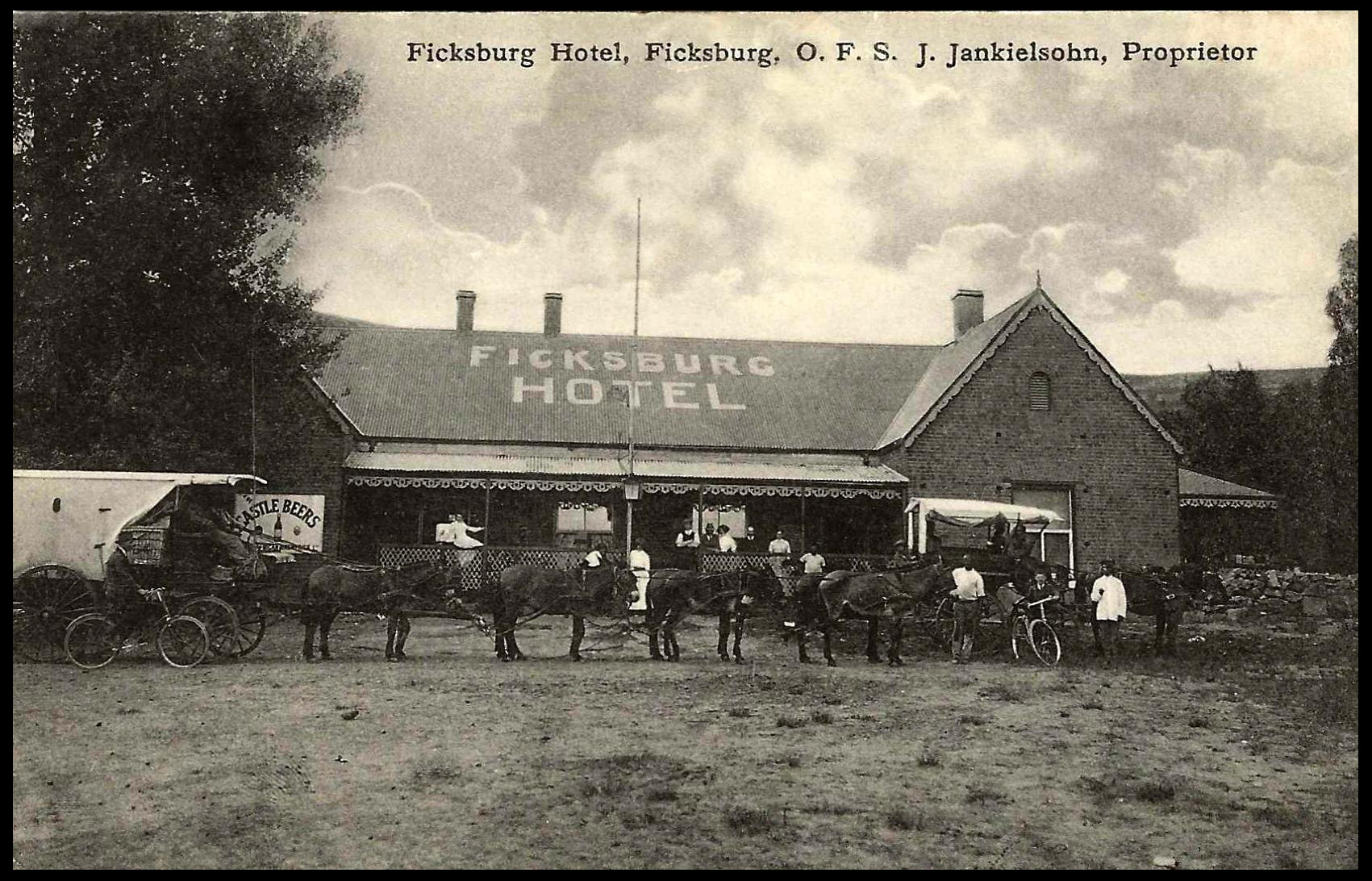
Circa 1898 - 1920. Postcard. Ficksburg Hotel, Ficksburg, O.F.S. J. Jankielsohn, Proprietor'.
With a little research I was able to narrow the date of this photo down to about 10 years.
This interesting postcard was difficult to date. I did not have a copy of its reverse. The postcard describes Ficksburg as being in the OFS (Orange Free State), an independent republic until the War saw it become a British colony, the ORC (Orange River Colony) in 1900 until 1910, (Union), when it became a province of the Union of South Africa called the Orange Free State. So, there is no specific clue to the date of the photo in its address. The brick and corrugated iron construction is typical of 1890 - 1920.
There are some clues in this postcard to its date which are not conclusive by themselves. The first is the sign for Castle Beers. Today, this thirst-quencher is usually referred to as 'Castle Lager'. (A lager is a type of beer.) Its history began in 1886 when Charles Glass established the Castle Brewery in Johannesburg. His 'Castle Beer' (not Lager) quickly became popular with the mining community. By 1889, 'The Digger’s News' described Glass' enterprise as a "success". In 1895, South African Breweries (SAB) was formed and two years later it was listed on the Johannesburg Stock Exchange (1897) ie. Castle Beer was popular before the SAW / ABW began in 1899. You can expect such a listed company to have an active marketing and promotions department producing advertising signage, etc..
In these early years SA Breweries' flagship product was 'Castle Beer'. This suggests that this photo could have been taken before the South African War of 1899 - 1902. Supporting this are the bicycles and two mule and or horse-drawn coaches that you can see and the absence of motor cars. Does this show that the photo was taken befor the arrival of motor cars?. Not really, all we can determine is that at this time in Ficksburg horse and carts remained the hotel's main means of transport. Given the devastation of the war it is possible that at this time few could afford motor vehicles. However, thirdly, the people gathered on the hotel's stoep (verandah) seem to be an affluent lot. Is this a happier time before the war? Perhaps. However, the hotel's name which is painted on its roof, a common practice, one which pilots in the early days of aviation in South Africa used as locational markers.
So, my first cautious guess was that the photo in this postcard could equally be from anytime between 1898 to 1920.
I now decided to research the proprietor of the Ficksburg Hotel, J. Jankielsohn. I should have started there. I found two references to him, the first a court case JANKIELSOHN v. REX of 7th July 1904 when he was the properietor of the Grand Hotel, Bloemfontein. This was a criminal procedure in which the charge was 'Permitting drunkenness.-Ordinance 8 of 1903, sec. 51, sub-sec. I.'
J (Jankielsohn) was the holder of a liquor license. He was charged with permitting drunkenness to take place in his retail liquor licensed premises. There was some evidence that J or his barmen had knowledge of a drunken man in the bar, if not they were culpably ignorant of his presence there. J was charged with permitting drunkenness to take place upon his retail liquor licensed premises known as the Grand Hotel, Bloemfontein. J was found guilty. The facts disclosed by the evidence show that on the night of the 10th June, 1904, 'a man went into the bar of the Grand Hotel in an intoxicated condition. He was staggering and being watched by two policemen who went into the bar a few minutes afterwards and found him sitting over a table with a bottle of Castle Beer to his lips'. Ha!
Okay, so now we know that J was the proprietor of the Grand Hotel, Bloemfontein, in 1904. In addition to this, I found this reference to J on-line, posted in 2005. entitled 'Hotel Proprietors in SA circa 1915'. This was cited in a ROOTSWEB List and names some hotel owners, apparently taken from the magazine ON THE ROAD (about 1915), one intended for South African commercial travellers, not proto-beatniks. Under 'F', it lists "Ficksburg Hotel, Ficksburg: J. JANKIELSOHN ("late proprietor Grand Hotel, Bloemfontein").
So there we have it, this postcard dates from some time after 1904 and "circa 1915". Let's say, 1920.
Please submit your thoughts., Thanks.
Footnote:
Dr Roy Jankielsohn (born 3 December 1967) is a South African politician who has been the leader of the opposition in the Free State Provincial Legislature since 2014. He has been the provincial leader of the Democratic Alliance (DA) in the Free State since 2020.
Quote from Steve on October 14, 2025, 12:28 pm.... en nog 'n Grand Hotel in Middelburg, Transvaal.
Circa 1898 - 1910. Postcard. 'Middelburg - Transvaal'. (1335. Published by Sallo Epstein & Co., Durban.)
Presumably the well-known postcard photographer and publisher, Sallo Epstein of Durban, chose not to mention the Grand Hotel by name in his caption because it is so obvious on the building's roof. This rather dull and uninteresting photograph looks like a study in loneliness amidst chaotic rural development. In reality, the building stands on the edge of a prosperous and decent-sized little town. Nevertheless, I look at this postcard and imagine that while weary coach travellers would welcome spending the night here, come the morning they would be itching to get on with their journey to arrive anywhere with more bright lights and hot-running water.
There is an excellent website showing the history of Middelburg that includes this postcard. It says "The road in front of the Hotel was the road from the Transvaal towards Lourenco Marques. The Hotel, located on the corner of Meyer and Jan van Riebeeck Streets just below the station, provided accommodation for rail travellers. The trees in the picture are on the site where the first Thos Begbies was established in Middelburg. Note the hawkers in the foreground. The man on the right seems to be standing at a milling machine of some sort. The three Indian men in the centre seem to be selling material. Card published by Sallo Epstein (circa 1905)."
I generally do not like to refer readers to other websites but I feel I would be doing you a disservice if I did not do so now. You must see this article about the history of Middelburg. It is superbly researched and richly adorned with postcards of the early town, its shops, schools, churches, government buildings including the court and post office, the railwaystation, the British Army's military cantonment plus another hotel, the Imperial. See "Early Middelburg through the eyes of two deltiologists, Rex Hilligan and Carol Hardijzer".
This is the sort of quality that you can expect to see.
.... en nog 'n Grand Hotel in Middelburg, Transvaal.
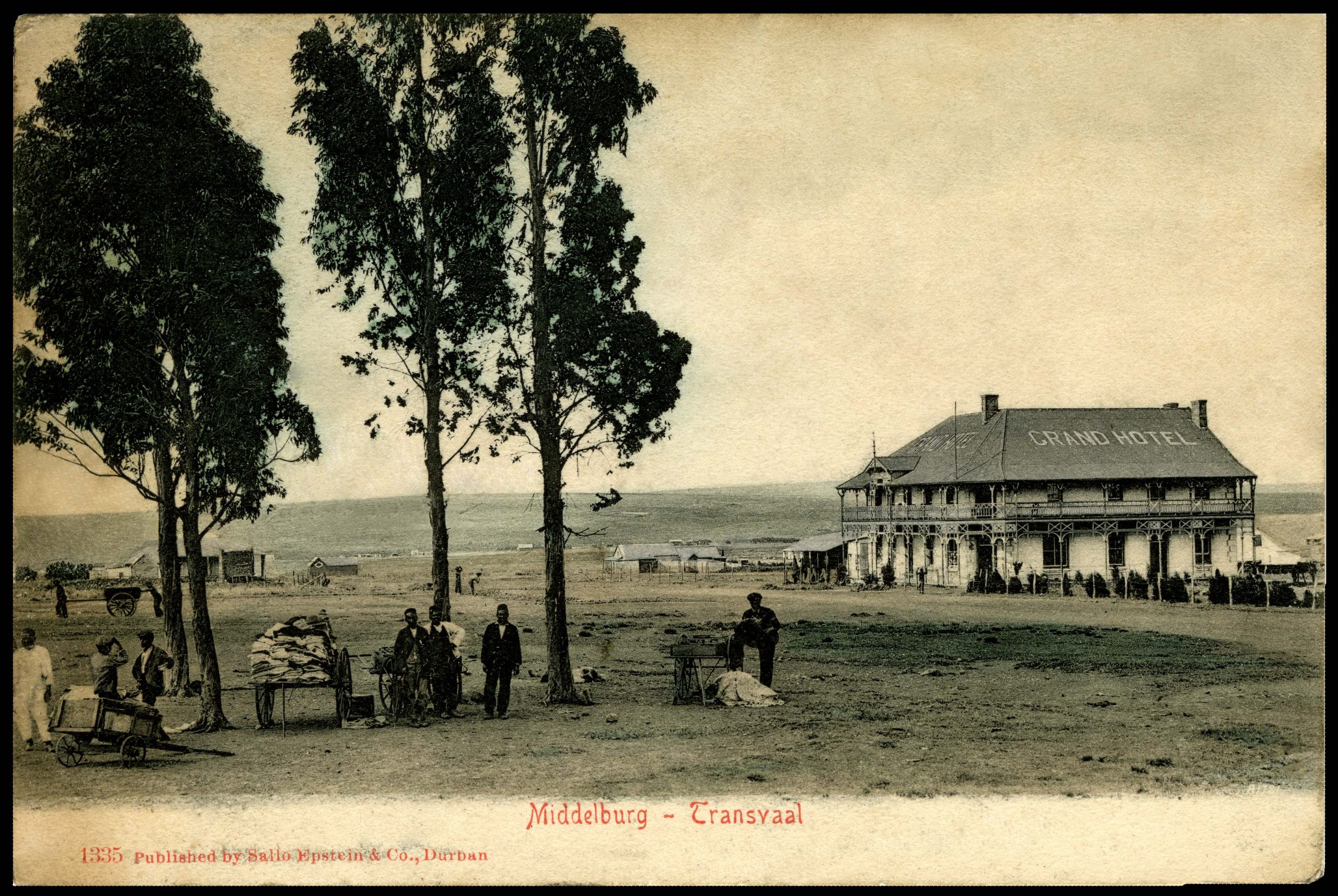
Circa 1898 - 1910. Postcard. 'Middelburg - Transvaal'. (1335. Published by Sallo Epstein & Co., Durban.)
Presumably the well-known postcard photographer and publisher, Sallo Epstein of Durban, chose not to mention the Grand Hotel by name in his caption because it is so obvious on the building's roof. This rather dull and uninteresting photograph looks like a study in loneliness amidst chaotic rural development. In reality, the building stands on the edge of a prosperous and decent-sized little town. Nevertheless, I look at this postcard and imagine that while weary coach travellers would welcome spending the night here, come the morning they would be itching to get on with their journey to arrive anywhere with more bright lights and hot-running water.
There is an excellent website showing the history of Middelburg that includes this postcard. It says "The road in front of the Hotel was the road from the Transvaal towards Lourenco Marques. The Hotel, located on the corner of Meyer and Jan van Riebeeck Streets just below the station, provided accommodation for rail travellers. The trees in the picture are on the site where the first Thos Begbies was established in Middelburg. Note the hawkers in the foreground. The man on the right seems to be standing at a milling machine of some sort. The three Indian men in the centre seem to be selling material. Card published by Sallo Epstein (circa 1905)."
I generally do not like to refer readers to other websites but I feel I would be doing you a disservice if I did not do so now. You must see this article about the history of Middelburg. It is superbly researched and richly adorned with postcards of the early town, its shops, schools, churches, government buildings including the court and post office, the railwaystation, the British Army's military cantonment plus another hotel, the Imperial. See "Early Middelburg through the eyes of two deltiologists, Rex Hilligan and Carol Hardijzer".

Quote from Steve on October 18, 2025, 1:02 pmBack to Hermanus - the Victoria Hotel, later the Astoria Hotel.
If you have been to Hermanus once, you have almost certainly returned. As boys and young men my pals and I went there hoping to sow our wild oats. Our teenage base was the camp site in Onrus, close to the Cock o' the South Hotel. From there we would hitchhike into Hermanus smelling of braai and too much Old Spice and go to the dance in the Astoria. Being callow under-age teenagers the best we could hope for was to get to dance. The girls were all older than us with boyfriends older than them. We did not stand a chance. We were 'lightys', sipping on vodka and orange juice, thinking how cool it was to be there listening to Jimmy Retief and the Idiots cover 'A Whiter Shade of Pale'. Then 'dronk', home to the camp site after midnight, perhaps in the back of a pick-up truck, a bakkie driven by a drunken driver. Get back, time for pay back, play Subterranean Homesick Blues. Bob Dylan in the bos mixing up the medicine, waking up the campers, making 'em think about their government! "It’s somethin’ that you did. Jump down a manhole. Light yourself a candle!". A shot rings out. "Bly stil!" (Afr. Keep quiet!)
Circa 1920. Photo. The Victoria Hotel, Hermanus, on the corner of Main Street.
Just visible over the street is what looks like 'Mrs M Brauckners Board and Residence'.
The town's emphasis was on accomodating holiday-makers but where were the restaurants?The Victoria Hotel was originally built as the home of Walter McFarlane who converted it into a double story to be used as a hotel in 1892. Thus was the first Hotel in the small fisherman's village then known as Hermanus Pietersfontein. The Victoria Hotel burnt down in 1954 and was rebuilt again but renamed the Astoria Hotel. More recently the building has become the Astoria Village shopping centre.
Circa 1954. The rebuilt Hotel Astoria with new gables and balconies.
It is hard to imagine that this is roundabout 1954. It looks earlier. See below.
Circa 1960. Real Photo Postcard. 'Main Street. Looking North. Hermanus. CP. 6'
The Hotel Astoria is on the extreme right - where the leggy girl is with her chaperone!
This is how I remember it in the mid-60s. This is the main road in from Cape Town.
There is now a low wall in front. Pedestrians now no longer walk under shelter.
The approaching car has a Hermanus CFM number plate.
I think the Post Office is the first building on the left.
You would not recognise Hermanus today.
Back to Hermanus - the Victoria Hotel, later the Astoria Hotel.
If you have been to Hermanus once, you have almost certainly returned. As boys and young men my pals and I went there hoping to sow our wild oats. Our teenage base was the camp site in Onrus, close to the Cock o' the South Hotel. From there we would hitchhike into Hermanus smelling of braai and too much Old Spice and go to the dance in the Astoria. Being callow under-age teenagers the best we could hope for was to get to dance. The girls were all older than us with boyfriends older than them. We did not stand a chance. We were 'lightys', sipping on vodka and orange juice, thinking how cool it was to be there listening to Jimmy Retief and the Idiots cover 'A Whiter Shade of Pale'. Then 'dronk', home to the camp site after midnight, perhaps in the back of a pick-up truck, a bakkie driven by a drunken driver. Get back, time for pay back, play Subterranean Homesick Blues. Bob Dylan in the bos mixing up the medicine, waking up the campers, making 'em think about their government! "It’s somethin’ that you did. Jump down a manhole. Light yourself a candle!". A shot rings out. "Bly stil!" (Afr. Keep quiet!)
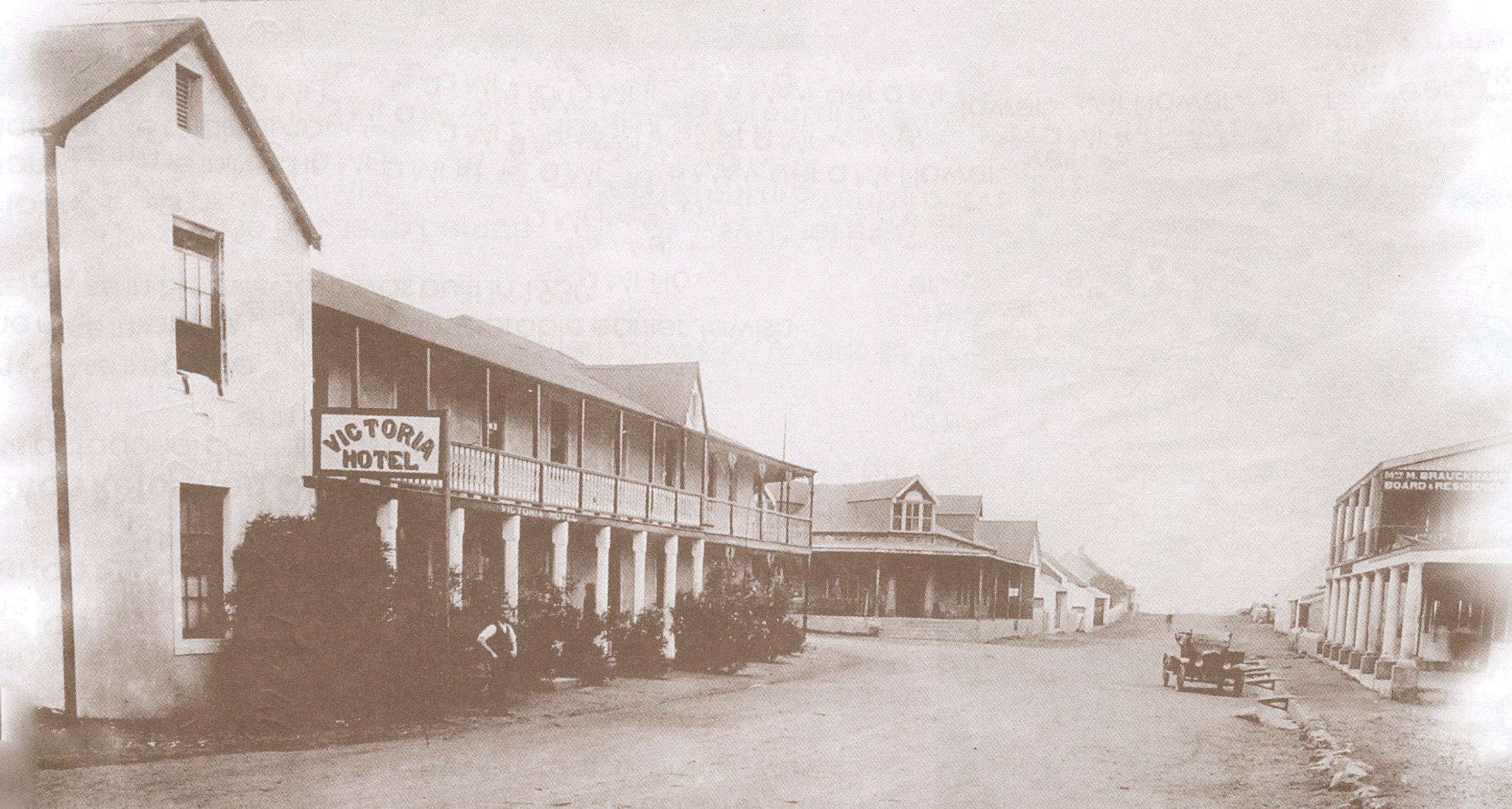
Circa 1920. Photo. The Victoria Hotel, Hermanus, on the corner of Main Street.
Just visible over the street is what looks like 'Mrs M Brauckners Board and Residence'.
The town's emphasis was on accomodating holiday-makers but where were the restaurants?
The Victoria Hotel was originally built as the home of Walter McFarlane who converted it into a double story to be used as a hotel in 1892. Thus was the first Hotel in the small fisherman's village then known as Hermanus Pietersfontein. The Victoria Hotel burnt down in 1954 and was rebuilt again but renamed the Astoria Hotel. More recently the building has become the Astoria Village shopping centre.
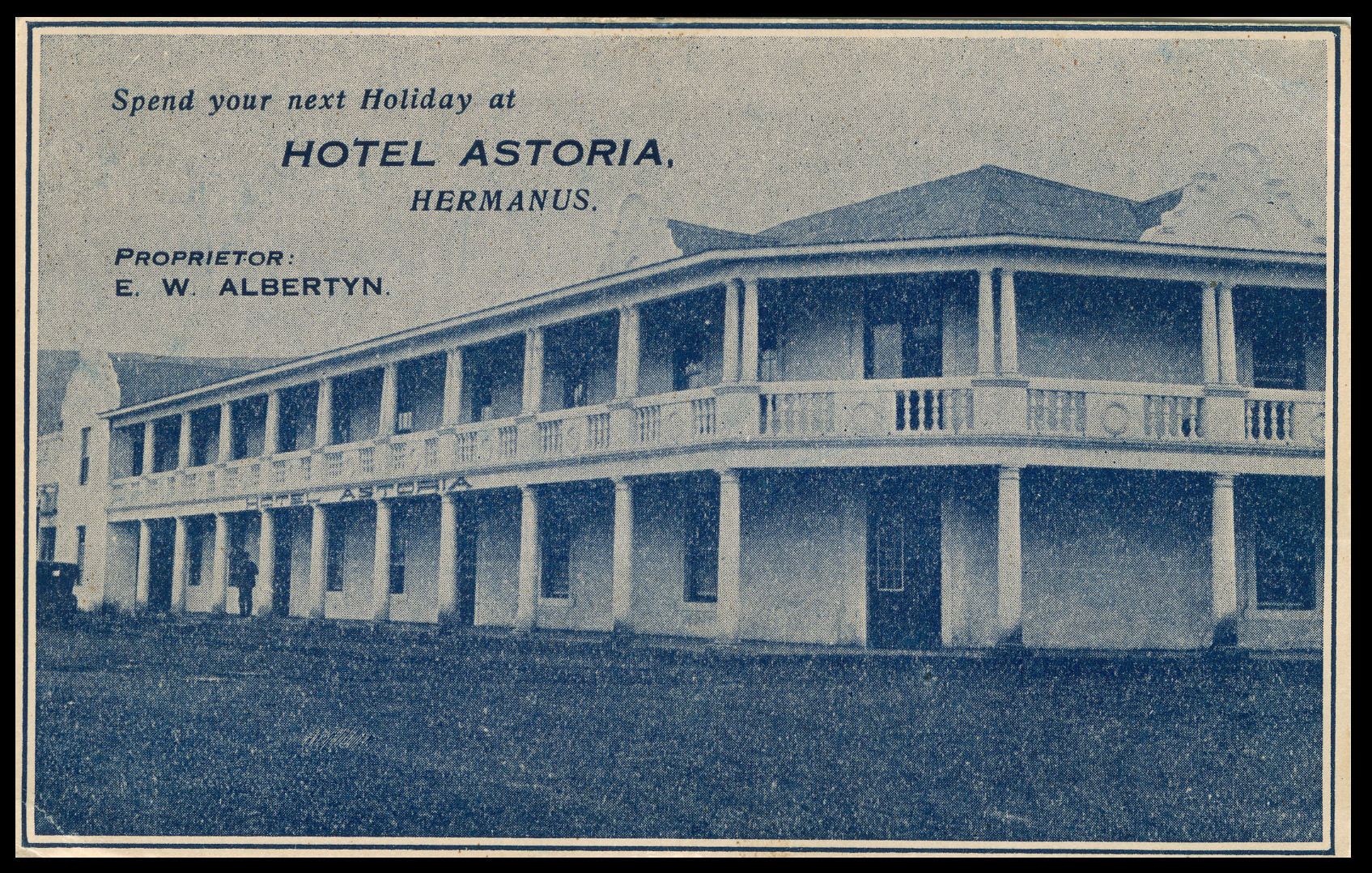
Circa 1954. The rebuilt Hotel Astoria with new gables and balconies.
It is hard to imagine that this is roundabout 1954. It looks earlier. See below.
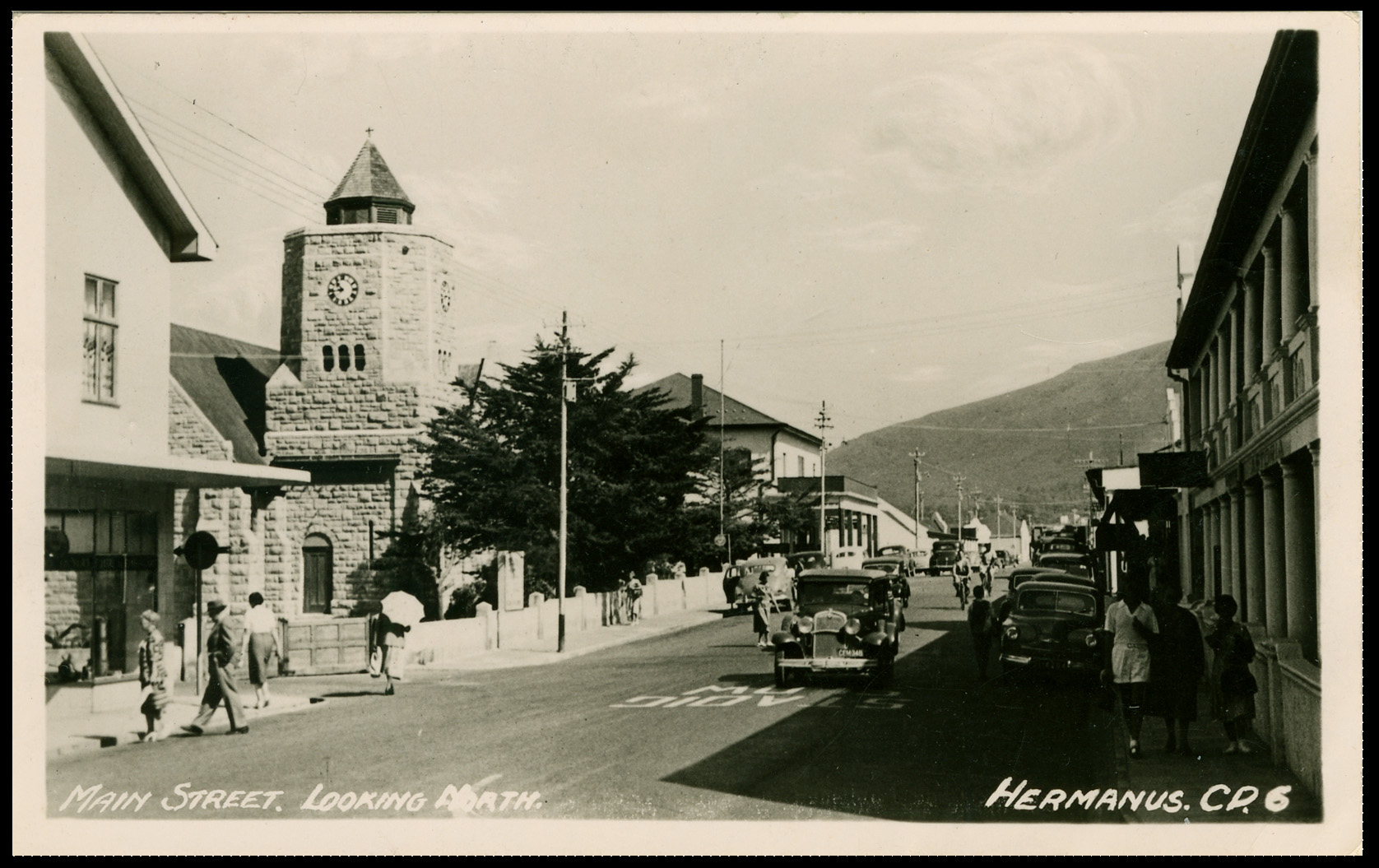
Circa 1960. Real Photo Postcard. 'Main Street. Looking North. Hermanus. CP. 6'
The Hotel Astoria is on the extreme right - where the leggy girl is with her chaperone!
This is how I remember it in the mid-60s. This is the main road in from Cape Town.
There is now a low wall in front. Pedestrians now no longer walk under shelter.
The approaching car has a Hermanus CFM number plate.
I think the Post Office is the first building on the left.
You would not recognise Hermanus today.
Quote from Steve on October 18, 2025, 3:59 pmHistoric Hermanus, a VC resident and a link (bottom) to an article on its many hotels.
(Originally Hermanuspietersfontein).
The recorded history of Hermanus begins in 1724. Up to this time indigenous people had lived in the vicinity for some 2000 years. A Khoi sub-group, the Strandlopers (beach-rangers), lived in seaside caves and grottos with a staple diet of seafood. At the nearby Die Kelders archaeological site a 1969 dig revealed pottery shards, stone and bone artifacts and the remains of shellfish, fish and other animals that the Khoi had discarded in a huge, meters high midden. Some Strandlopers survived in the area until the early 1900’s.
Stellenbosch farmer, Jan Cloete, obtained grazing rights to the area in 1724, and his uncle, Hendrik Cloete of Groot Constantia fame, bought the Mosselrivier farmland in 1787 where he built the first holiday home, 'The Mondhuis', (at the mouth of the river). Duncan McFarlane acquired the Mosselrivier farm in 1857 and built the second holiday home, 'The Homestead', there. His children inherited the old farm and laid out Poole’s Bay (today Eastcliff) and Mossel River Estate (todayVoëlklip), both eastern suburbs of Hermanus.
Circa 1920. Commercial Postcard. Unused. 'Kraal Rock Tea Garden, Poole's Bay. Hermanus, CP.'
Click on this link to read a letter in which the Pooles of Hermanus are referenced.
Hermanus Pieters was a Hollander teaching at Boontjieskraal in the 1820’s. He needed grazing land for some cattle he had received in part-payment of a salary. He investigated the coastal lands where he discovered lush grass and a spring which became known as 'Hermanuspietersfontein'. Pieters died in 1837 and never lived to see the village that bore his name come in to being. In 1854 12 plots were surveyed at Hermanuspietersfontein and auctioned in Caledon in 1855. However, the first plot-holders never settled there. It was left to Michael Henn, a fisherman with a thriving business at Herrie’s Bay (Hawston) to become the first resident. In 1857 he relocated to Hermanuspietersfontein with his large family, founding what was once arguably South Africa's premier fishing village.
The fishing village developed slowly. A village Management Board was constituted in 1891. Hermanuspietersfontein now had two schools, two churches, a hotel, (the Victoria), several shops and a Post Office. In 1902 the postmaster shortened the town's long name to Hermanus. Two years later a municipality was proclaimed under the new name. The town's superb rock fishing increased visitor numbers. Better facilities and more hotels were built for a growing number of holidaymakers, many summer visitors from the farms of the hinterland and also Cape Town. Sea swimming at Voëlklip beach and Riviera beach (Grotto beach) was rough and bracing. Tidal pools at the Marine Hotel and at Fick’s pool in Westcliff made a dip less challenging. Transport was by ox-wagon or horse and cart. A trip from Cape Town took four days. The railway ran only as far as Bot River. A bus service to Hermanus was introduced in 1912.
In the 1960’s Southern Right whales began returning to area after having been almost exterminated in coastal waters by the local and foreign whaling industry during the 300 years of the Cape's colonial settlement. Just as fish and fishing had created Hermanus in the first instance, few realised how the Southern Right whales would change Hermanus in future. Today it is the whale watching capital of South Africa, drawing thousands of international tourists every year. Coastal paths allow easy access to whale-watching vantage points.
One WW1 serviceman who found the cliffside paths a place for reflection, enough so to have his ashes scatted at XXXX, was South African hero, Corporal William Hewitt VC of the South African Brigade. He won his conspicuous gallantry medal in 1917 during the Third Battle of Ypres, Passchendaele. In 1950 he retired to Hermanus with his wife Lily. After he died in 1966 a bench was placed on the cliff path and named in memory after him. Many years ago the Hermanus Council sold it to a notable Afrikaner family who wanted their dearly beloved remembered to the exclusion of all others.
1918. Corporal William Hewitt VC, 2nd South African Light Infantry Brigade. France.
1884. Born Framlingham, Ipswich, England.
1905. Emigrated to SA. Joined SA Constabulary.
1906 - 1909. Joined Natal Police. Awarded Natal Rebellion Medal 1906/7.
1908 - 1915. Farming in Kenya.
1915. Enlisted in the 2nd SA Light Infantry.
1916. Fought at Delville Wood. Wounded at Warlencourt.
1917. Wounded and awarded the VC for his action on the Menin Road.
1918. Invested with the VC by King Geo V. Promoted Lieutenant.
1920 - 1950. Coffee farming in Kenya. Holidays in Hermanus.
1939 - 1945. WW2. Promoted Major, Provost Marshall Mombasa.
1950 - 1961. Retirement in Hermanus.
1966. Died in UK. Ashes scatted off Hermanus.Another more high profile South African was Roger Bushell, the Johannesburg-born, British barrister and RAF Squadron Leader who as Big X organised the famous WW2 'Great Escape'. He was played by Richard Attenborough in the movie of the same name. His parents retired to a holiday home in Voëlklip, Hermanus. Sadly, Roger never got to visit them there. After escaping he and 50 captured escapees were murdered by the Gestapo on Hitler's orders. Roger is commemorated on a plaque on the gun that stands above the old fishing harbour just off the town square.
Hermanus is now a home for affluent up-country folk who want to live in or retire to the relative security of the Western Cape. It has changed out of all recognition from a sleepy Cape fishing village into one embraces a hodge-podge of all the world's architectural styles. It has grown so much that its poor baboons who once scavenged the shoreline can no longer cross the sprawling town to get there from the hills and mountains without causing serious distress to the suburbanites who would happily kill them as vermin. As bad, Hermanus is largely fished-out, the victim of its own success. I take angry satisfaction from the fact that for years disaffected vandals have disabused the town by removing the 'm' from Hermanus signs. This much was still obvious on my last visit. Some things never change!
Historic Hermanus, a VC resident and a link (bottom) to an article on its many hotels.
(Originally Hermanuspietersfontein).
The recorded history of Hermanus begins in 1724. Up to this time indigenous people had lived in the vicinity for some 2000 years. A Khoi sub-group, the Strandlopers (beach-rangers), lived in seaside caves and grottos with a staple diet of seafood. At the nearby Die Kelders archaeological site a 1969 dig revealed pottery shards, stone and bone artifacts and the remains of shellfish, fish and other animals that the Khoi had discarded in a huge, meters high midden. Some Strandlopers survived in the area until the early 1900’s.
Stellenbosch farmer, Jan Cloete, obtained grazing rights to the area in 1724, and his uncle, Hendrik Cloete of Groot Constantia fame, bought the Mosselrivier farmland in 1787 where he built the first holiday home, 'The Mondhuis', (at the mouth of the river). Duncan McFarlane acquired the Mosselrivier farm in 1857 and built the second holiday home, 'The Homestead', there. His children inherited the old farm and laid out Poole’s Bay (today Eastcliff) and Mossel River Estate (todayVoëlklip), both eastern suburbs of Hermanus.
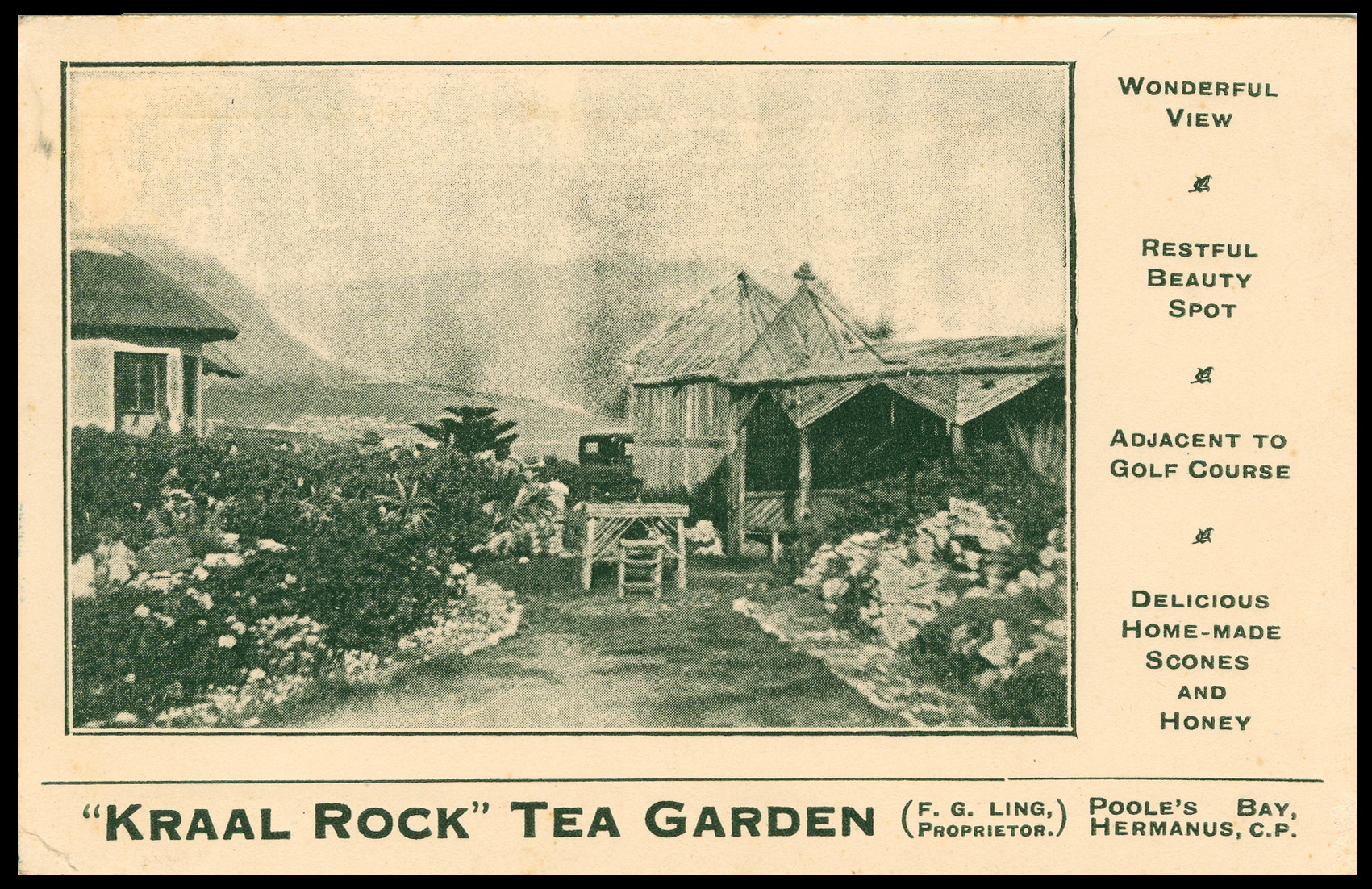
Circa 1920. Commercial Postcard. Unused. 'Kraal Rock Tea Garden, Poole's Bay. Hermanus, CP.'
Click on this link to read a letter in which the Pooles of Hermanus are referenced.
Hermanus Pieters was a Hollander teaching at Boontjieskraal in the 1820’s. He needed grazing land for some cattle he had received in part-payment of a salary. He investigated the coastal lands where he discovered lush grass and a spring which became known as 'Hermanuspietersfontein'. Pieters died in 1837 and never lived to see the village that bore his name come in to being. In 1854 12 plots were surveyed at Hermanuspietersfontein and auctioned in Caledon in 1855. However, the first plot-holders never settled there. It was left to Michael Henn, a fisherman with a thriving business at Herrie’s Bay (Hawston) to become the first resident. In 1857 he relocated to Hermanuspietersfontein with his large family, founding what was once arguably South Africa's premier fishing village.
The fishing village developed slowly. A village Management Board was constituted in 1891. Hermanuspietersfontein now had two schools, two churches, a hotel, (the Victoria), several shops and a Post Office. In 1902 the postmaster shortened the town's long name to Hermanus. Two years later a municipality was proclaimed under the new name. The town's superb rock fishing increased visitor numbers. Better facilities and more hotels were built for a growing number of holidaymakers, many summer visitors from the farms of the hinterland and also Cape Town. Sea swimming at Voëlklip beach and Riviera beach (Grotto beach) was rough and bracing. Tidal pools at the Marine Hotel and at Fick’s pool in Westcliff made a dip less challenging. Transport was by ox-wagon or horse and cart. A trip from Cape Town took four days. The railway ran only as far as Bot River. A bus service to Hermanus was introduced in 1912.
In the 1960’s Southern Right whales began returning to area after having been almost exterminated in coastal waters by the local and foreign whaling industry during the 300 years of the Cape's colonial settlement. Just as fish and fishing had created Hermanus in the first instance, few realised how the Southern Right whales would change Hermanus in future. Today it is the whale watching capital of South Africa, drawing thousands of international tourists every year. Coastal paths allow easy access to whale-watching vantage points.
One WW1 serviceman who found the cliffside paths a place for reflection, enough so to have his ashes scatted at XXXX, was South African hero, Corporal William Hewitt VC of the South African Brigade. He won his conspicuous gallantry medal in 1917 during the Third Battle of Ypres, Passchendaele. In 1950 he retired to Hermanus with his wife Lily. After he died in 1966 a bench was placed on the cliff path and named in memory after him. Many years ago the Hermanus Council sold it to a notable Afrikaner family who wanted their dearly beloved remembered to the exclusion of all others.
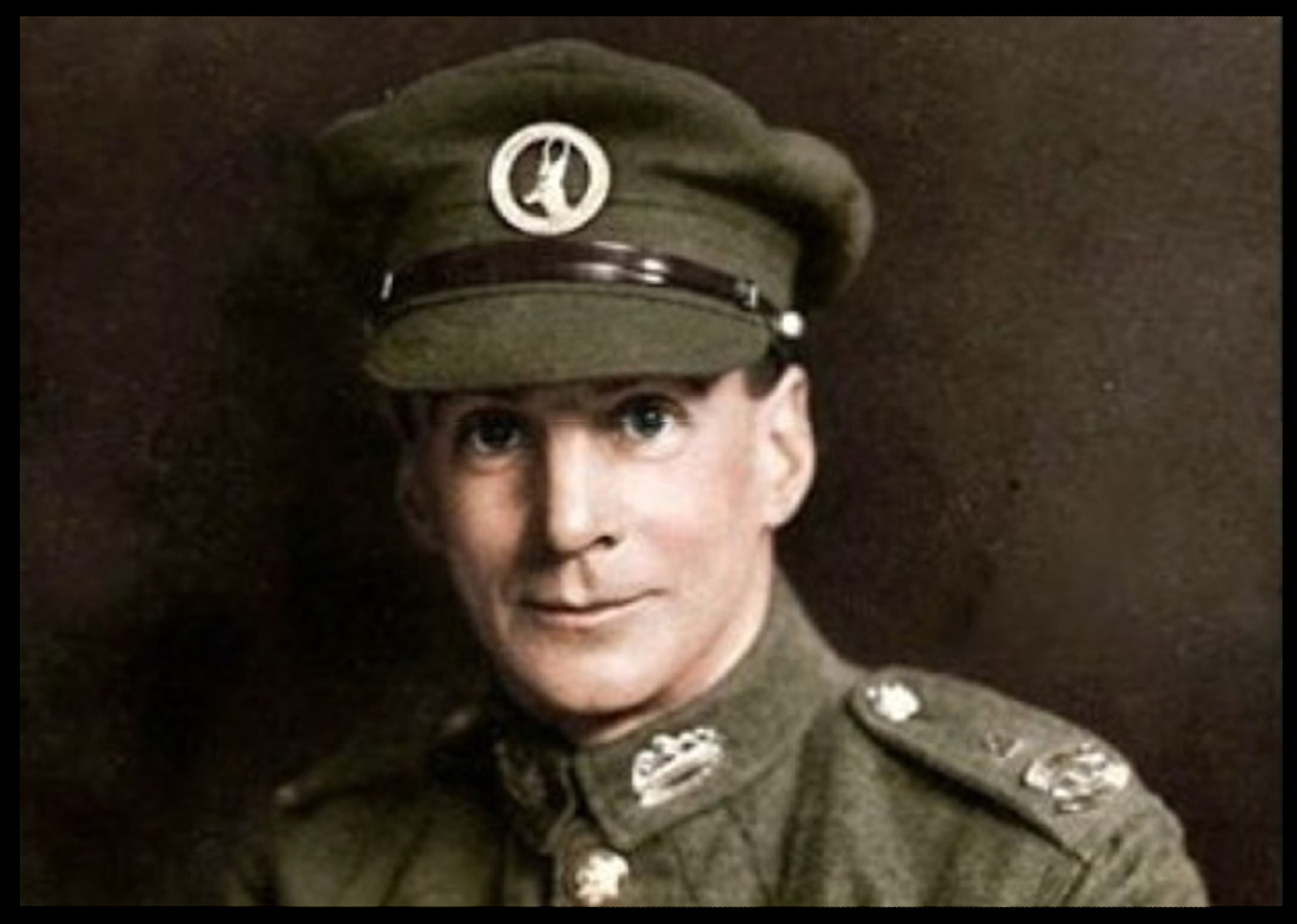
1918. Corporal William Hewitt VC, 2nd South African Light Infantry Brigade. France.
1884. Born Framlingham, Ipswich, England.
1905. Emigrated to SA. Joined SA Constabulary.
1906 - 1909. Joined Natal Police. Awarded Natal Rebellion Medal 1906/7.
1908 - 1915. Farming in Kenya.
1915. Enlisted in the 2nd SA Light Infantry.
1916. Fought at Delville Wood. Wounded at Warlencourt.
1917. Wounded and awarded the VC for his action on the Menin Road.
1918. Invested with the VC by King Geo V. Promoted Lieutenant.
1920 - 1950. Coffee farming in Kenya. Holidays in Hermanus.
1939 - 1945. WW2. Promoted Major, Provost Marshall Mombasa.
1950 - 1961. Retirement in Hermanus.
1966. Died in UK. Ashes scatted off Hermanus.
Another more high profile South African was Roger Bushell, the Johannesburg-born, British barrister and RAF Squadron Leader who as Big X organised the famous WW2 'Great Escape'. He was played by Richard Attenborough in the movie of the same name. His parents retired to a holiday home in Voëlklip, Hermanus. Sadly, Roger never got to visit them there. After escaping he and 50 captured escapees were murdered by the Gestapo on Hitler's orders. Roger is commemorated on a plaque on the gun that stands above the old fishing harbour just off the town square.
Hermanus is now a home for affluent up-country folk who want to live in or retire to the relative security of the Western Cape. It has changed out of all recognition from a sleepy Cape fishing village into one embraces a hodge-podge of all the world's architectural styles. It has grown so much that its poor baboons who once scavenged the shoreline can no longer cross the sprawling town to get there from the hills and mountains without causing serious distress to the suburbanites who would happily kill them as vermin. As bad, Hermanus is largely fished-out, the victim of its own success. I take angry satisfaction from the fact that for years disaffected vandals have disabused the town by removing the 'm' from Hermanus signs. This much was still obvious on my last visit. Some things never change!
Quote from Steve on October 23, 2025, 3:25 pmEdwards' Hotel, Colenso, Natal
This hotel is unusual in that it promotes itself by its proximity to a battlefield rather than the quality of its hospitatlity.
1903. Postcard. COLENSO NATAL '17 MY 03' to INSINZA, ZULULAND.
The South African War (aka Anglo-Boer War) had ended just under a year earlier.I have found no information on an Edwards' Hotel in Colenso. There was one in Durban and another in Margate. My guess is that whichever was the bigger, presumably the one in Durban, it provided postcards for the benefit of its guests (and their friends in SA and abroad) which showed scenes from the South African War and others in Natal. Can anyone confirm this with examples, please.
Edwards' Hotel, Colenso, Natal
This hotel is unusual in that it promotes itself by its proximity to a battlefield rather than the quality of its hospitatlity.
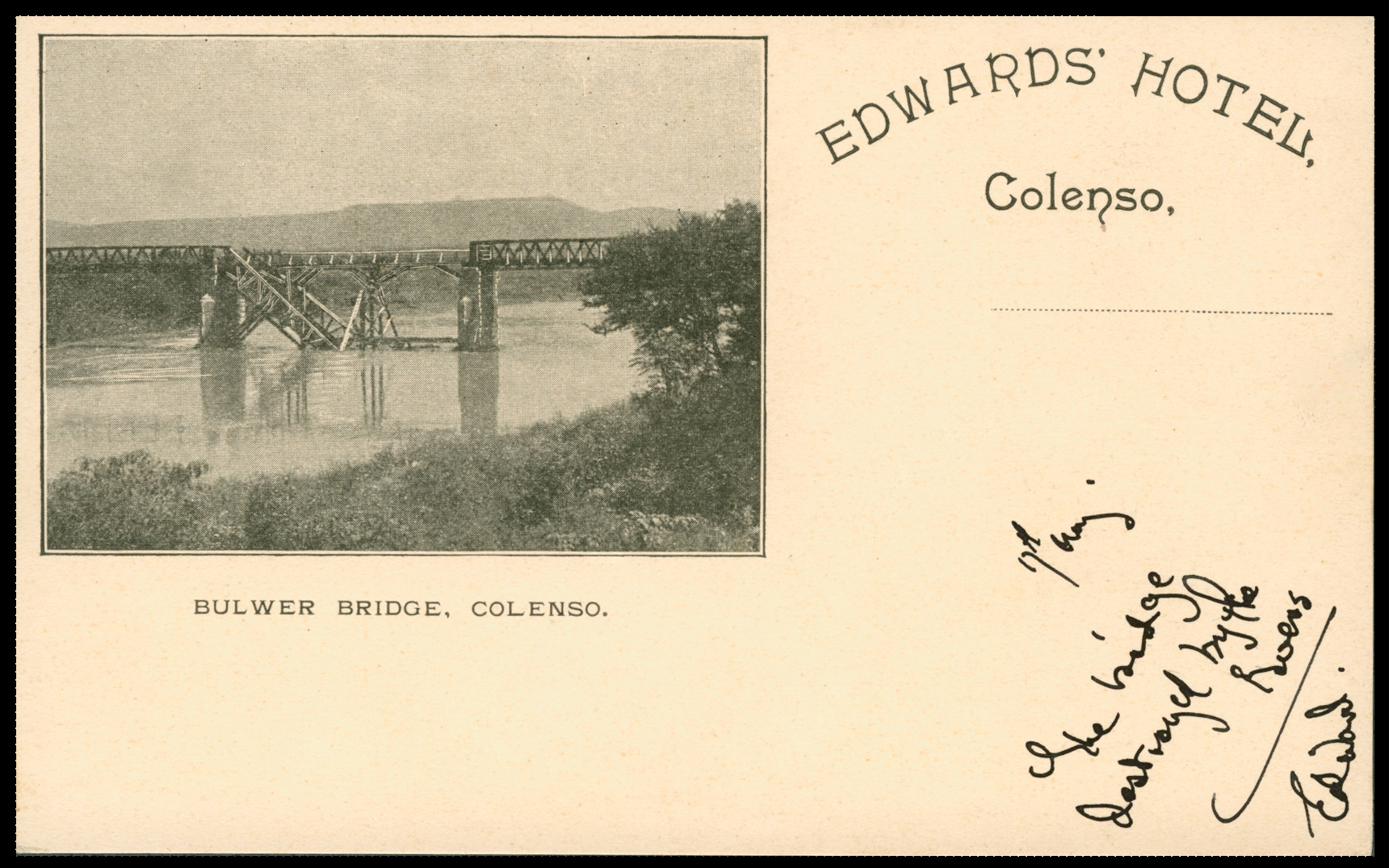
1903. Postcard. COLENSO NATAL '17 MY 03' to INSINZA, ZULULAND.
The South African War (aka Anglo-Boer War) had ended just under a year earlier.
I have found no information on an Edwards' Hotel in Colenso. There was one in Durban and another in Margate. My guess is that whichever was the bigger, presumably the one in Durban, it provided postcards for the benefit of its guests (and their friends in SA and abroad) which showed scenes from the South African War and others in Natal. Can anyone confirm this with examples, please.
Quote from Steve on October 29, 2025, 6:23 pmImperial Hotel, Port Shepstone, Natal South Coast.
1906. Postcard. DURBAN NATAL 'SP 16 06' to LONDON. (P. S. & C. - Box 294 - Durban.)
Smartly attired 'Indian' hotel staff stand to attention.The first hotel in Port Shepstone opened in 1881. It was situated about three miles up the uMzimkhulu river. This was probably not the Imperial Hotel which stood on the right on a hill above the river as you enter Port Shepstone. The Imperial Hotel was a magnificent double storey corrugated iron structure built in about 1899 or earlier. There was a launch that took guests on day trips up the river. Over time the Imperial Hotel became popular dance venue for South Coast residents. This view of it does not show the scarey old bridge with a wooden plank pedestrian walkway that some remember on the side of the building.
Port Shepstone, previously known as “Nomansland”, was annexed to the Colony of Natal on 1st January 1866 in a ceremony presided over by the then Acting-Governor, Col. John Jervis Bisset. This took place on the banks of the uMthamvuna River. The new territory was named Alfred Counry after the second son of Queen Victoria, who had visited Natal in 1860. The name, Port Shepstone, derived from a Proclamation issued by Col. Bisset on 15th January 1866 from the banks of the uMzimkhulu River. The eponymous Theophilus Shepstone, the Secretary of Native Affairs, had accompanied Bisset to the uMthamvuna on the occasion of the annexation.
Early indications of the Natal South Coast’s future as a tourist and holiday destination were evident from advertisements in the Natal Mercury. Under hotels in the business directory of the paper, apart from Durban and the Midlands, the only other hotels featured were those at Port Shepstone and Umkomaas. The North Coast did not feature at all. In 1903 there were four hotels in Port Shepstone – The Royal, The Imperial, The Beach and The Port Shepstone. An advertisement in the Natal Mercury on 5th December 1904 referred to Port Shepstone as the “Blackpool of South Africa – the most beautiful resort in Natal”. An advertisement for the Imperial Hotel in 1906 stated: “Splendid boating, fishing and bathing almost at the door. Good shooting in the immediate neighbourhood.”
Those who want to know more about the development of the Natal South Coast, specifically Port Shepstone, should read Duncan du Bois' "A glimpse at colonial Alfred County and Port Shepstone".
Imperial Hotel, Port Shepstone, Natal South Coast.

1906. Postcard. DURBAN NATAL 'SP 16 06' to LONDON. (P. S. & C. - Box 294 - Durban.)
Smartly attired 'Indian' hotel staff stand to attention.
The first hotel in Port Shepstone opened in 1881. It was situated about three miles up the uMzimkhulu river. This was probably not the Imperial Hotel which stood on the right on a hill above the river as you enter Port Shepstone. The Imperial Hotel was a magnificent double storey corrugated iron structure built in about 1899 or earlier. There was a launch that took guests on day trips up the river. Over time the Imperial Hotel became popular dance venue for South Coast residents. This view of it does not show the scarey old bridge with a wooden plank pedestrian walkway that some remember on the side of the building.
Port Shepstone, previously known as “Nomansland”, was annexed to the Colony of Natal on 1st January 1866 in a ceremony presided over by the then Acting-Governor, Col. John Jervis Bisset. This took place on the banks of the uMthamvuna River. The new territory was named Alfred Counry after the second son of Queen Victoria, who had visited Natal in 1860. The name, Port Shepstone, derived from a Proclamation issued by Col. Bisset on 15th January 1866 from the banks of the uMzimkhulu River. The eponymous Theophilus Shepstone, the Secretary of Native Affairs, had accompanied Bisset to the uMthamvuna on the occasion of the annexation.
Early indications of the Natal South Coast’s future as a tourist and holiday destination were evident from advertisements in the Natal Mercury. Under hotels in the business directory of the paper, apart from Durban and the Midlands, the only other hotels featured were those at Port Shepstone and Umkomaas. The North Coast did not feature at all. In 1903 there were four hotels in Port Shepstone – The Royal, The Imperial, The Beach and The Port Shepstone. An advertisement in the Natal Mercury on 5th December 1904 referred to Port Shepstone as the “Blackpool of South Africa – the most beautiful resort in Natal”. An advertisement for the Imperial Hotel in 1906 stated: “Splendid boating, fishing and bathing almost at the door. Good shooting in the immediate neighbourhood.”
Those who want to know more about the development of the Natal South Coast, specifically Port Shepstone, should read Duncan du Bois' "A glimpse at colonial Alfred County and Port Shepstone".
